How To Change A Thermostate On A 2000 Bmw 323i
Affiliate link disclosure – The BMW Repair Guide uses chapter links in their site. For more than information on chapter links, delight click here.
The post-obit article provides detailed instructions on performing a thermostat replacement on a BMW E46 3 series auto. Fifty-fifty though we take used a 2003 BMW 325ci to perform this installation, this article can be applied to any E46 3 series vehicle, including the 323i, 328i and 330i coupe, sedan and convertible.
The BMW E46 thermostat is an integral part of the motorcar's cooling system. Its primary function is controlling the amount of coolant flowing into the engine block from the vehicle's radiator. When the BMW E46 engine is running "cold", the thermostat remains closed blocking coolant from circulating through the engine block. As the motor slowly heats up, the thermostat opens allowing fluid to travel in which prevents the engine from overheating.
The thermostat is finer a valve that opens and closes depending on the temperature of the engine. It allows the engine to warm up correctly and prevents premature wear of critical parts in your vehicle's ability institute. If the coolant was allowed to flow through a cold engine, the motor would struggle to reach operating temperature and would not run efficiently. Indications that your BMW E46 thermostat has failed include the engine struggling to reach operating temperature and erratic changes in the temperature estimate. The BMW E46 thermostat has a "neglect-safe" mechanism that keeps it in the open up position if it completely shuts down, so engine overheating is usually not associated with thermostat failure in this model three series.
The BMW E46 thermostat is located within a plastic housing on the front of the engine. The plastic housing has its own prepare of known issues including leaking from cracks and onetime gaskets. The brutal heat conditions inside the E46 engine can crusade the plastic thermostat housing to fracture over time, assuasive coolant to leak out. The thermostat housing gasket is also susceptible to heat and age, causing information technology to become brittle and assuasive fluid to escape. A typical sign of a leaking thermostat housing is a pool of coolant under the engine of the machine, especially later on it has warmed up. A leaking thermostat housing should exist replaced immediately to avoid loss of coolant and possible engine overheating.
The BMW E46 thermostat and housing are unremarkably purchased as one unit. The BMW Repair Guide does not recommend replacing 1 without the other.
![]()
×
E46 iii Series - All Models
| BMW | E46 | 323Ci | M52 2.5L |
| BMW | E46 | 323i | M52 2.5L |
| BMW | E46 | 325Ci | M54 2.5L |
| BMW | E46 | 325i | M54 ii.5L |
| BMW | E46 | 325xi | M54 2.5L |
| BMW | E46 | 328Ci | M52 ii.8L |
| BMW | E46 | 328i | M52 ii.8L |
| BMW | E46 | 330Ci | M54 3.0L |
| BMW | E46 | 330i | M54 three.0L |
| BMW | E46 | 330xi | M54 3.0L |
| BMW | E46 | M3 | S54 3.2L |
![]()
![]()
![]()
Includes detailed part diagrams, function numbers and links to purchase all of the required components needed to complete this repair.

Before starting this repair, y'all must have the following required parts.
All BMW E46 vehicles
This is the same manufacturing plant thermostat that would be installed at the BMW dealership.
All BMW E46 vehicles
A mutual item to cleft causing leaks.
Fits all BMW vehicles
This is the same Genuine BMW coolant you would buy from the dealership.
All BMW E46 models
This is the aforementioned manufacturing plant radiator hose that would be installed at the BMW dealership.
All BMW E46 models
This is the same factory radiator hose that would be installed at the BMW dealership.
Department ane - Removing the BMW E46 Thermostat
Removing the quondam thermostat from your BMW E46 is a relatively simple procedure that can exist done in less than an 60 minutes.
- Jack and back up the front of the motorcar. Not sure how to jack and support your E46? See our commodity BMW Jacking and Supporting for Repairs and Maintenance.
- If the belly pan (aka – skid plate or lower engine encompass) is notwithstanding installed on your vehicle, remove it using an 8mm nut driver. Belly pans tend to disappear on older BMWs – they take a lot of abuse and are one of those parts that owners just don't spend money on replacing. The belly pan needs to be removed considering the coolant system needs to exist tuckered.
- Moving to the engine compartment, disconnect the mass air flow (MAF) sensor.
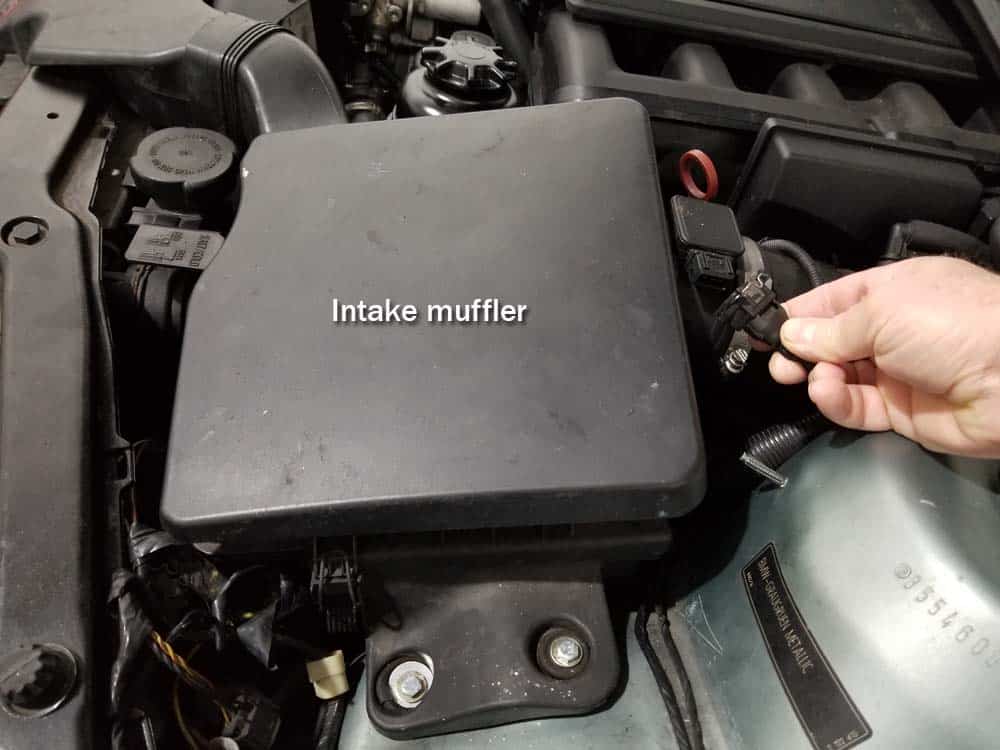
- Using a flat bract screwdriver, loosen the hose clamp on the intake boot.
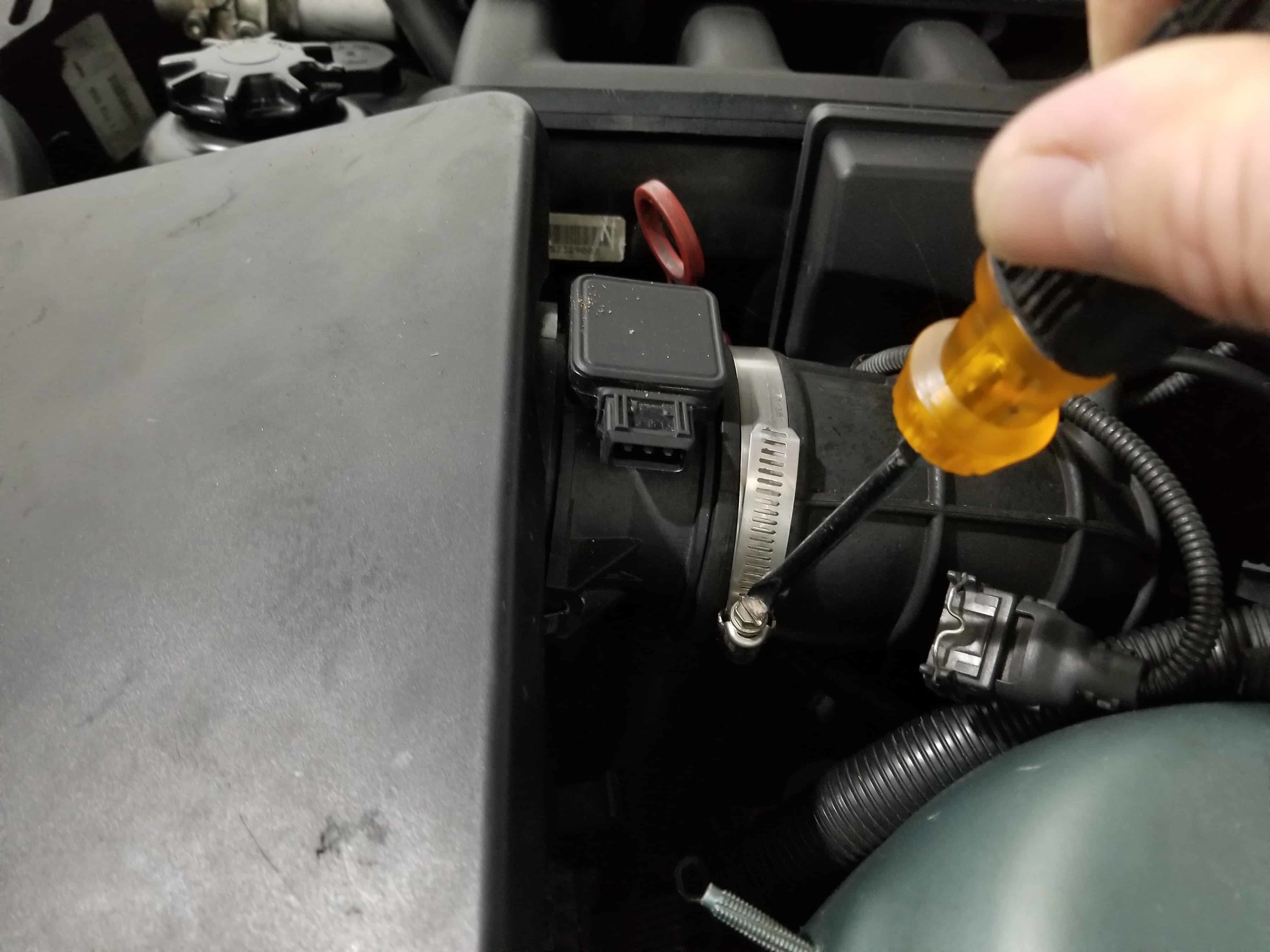
- Unlatch the 4 clamps on the lid of the intake muffler. Note that one of the clamps is difficult to get to…use a metal pick to release if you tin't achieve it with your fingers. Remove the lid from the vehicle.
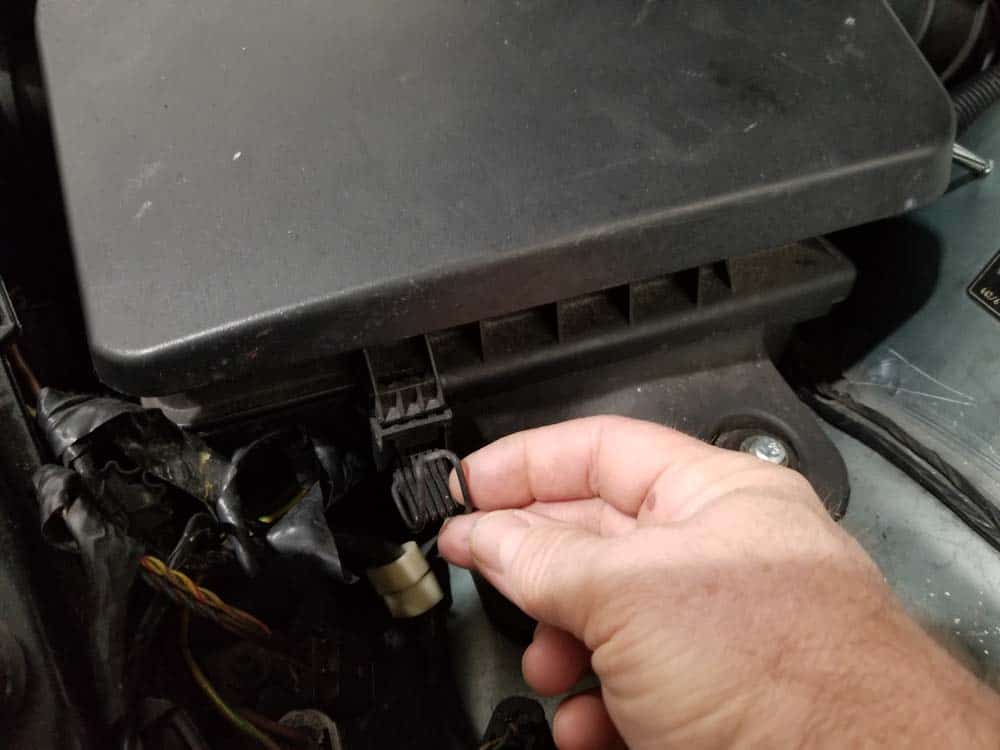
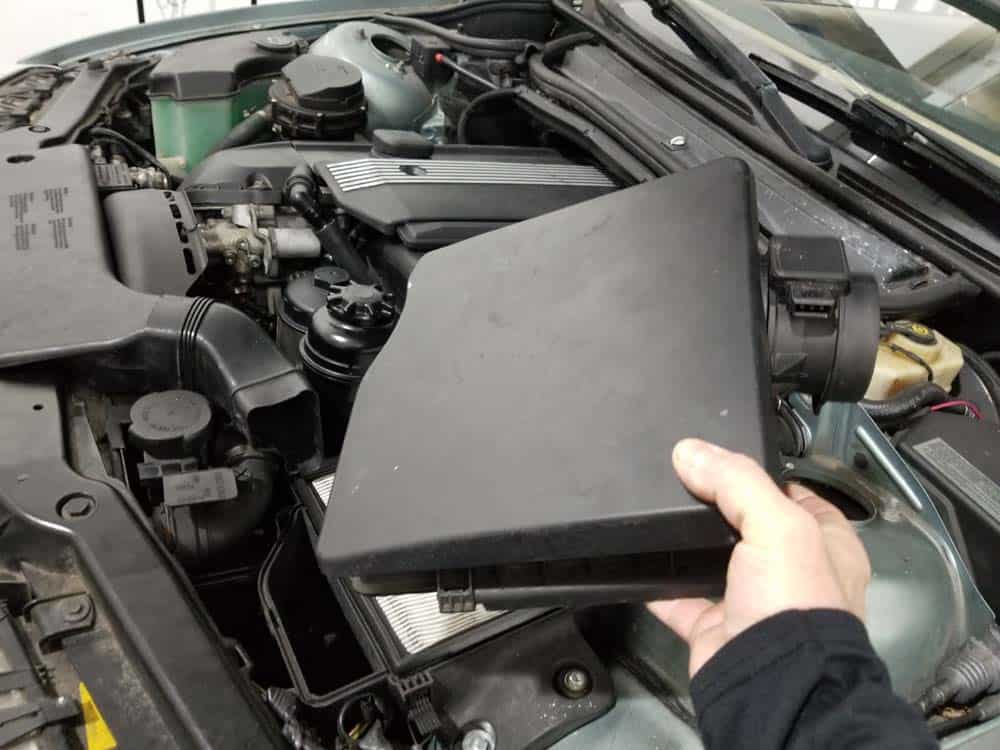
- Using a 10mm socket wrench, remove the two intake muffler mounting bolts. Remove the intake muffler from the engine compartment.
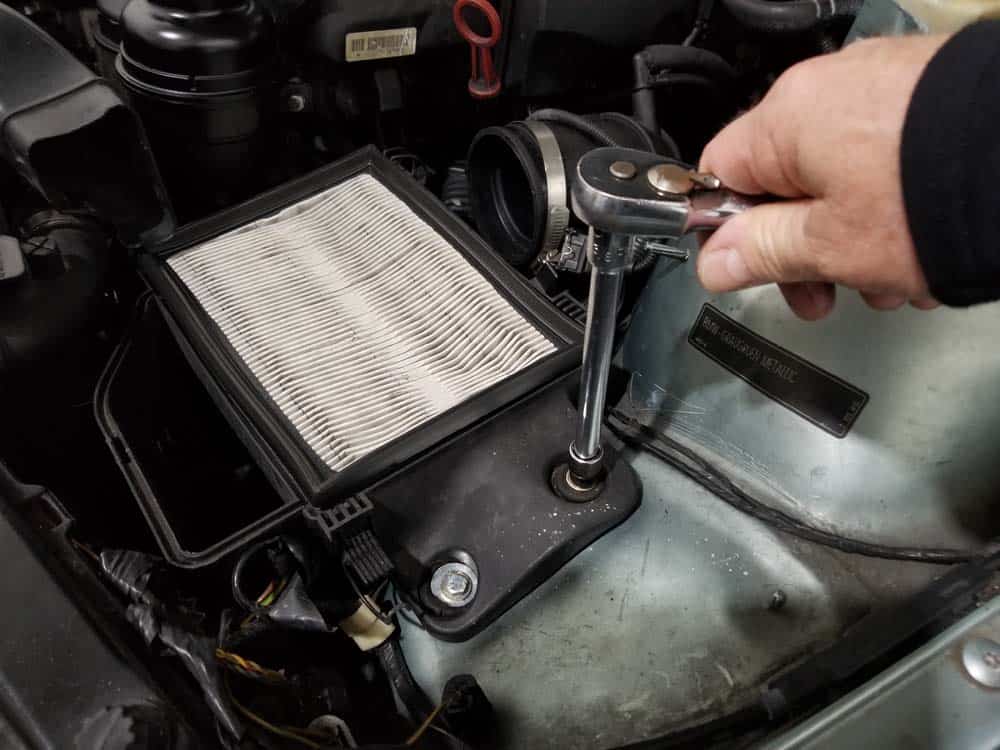
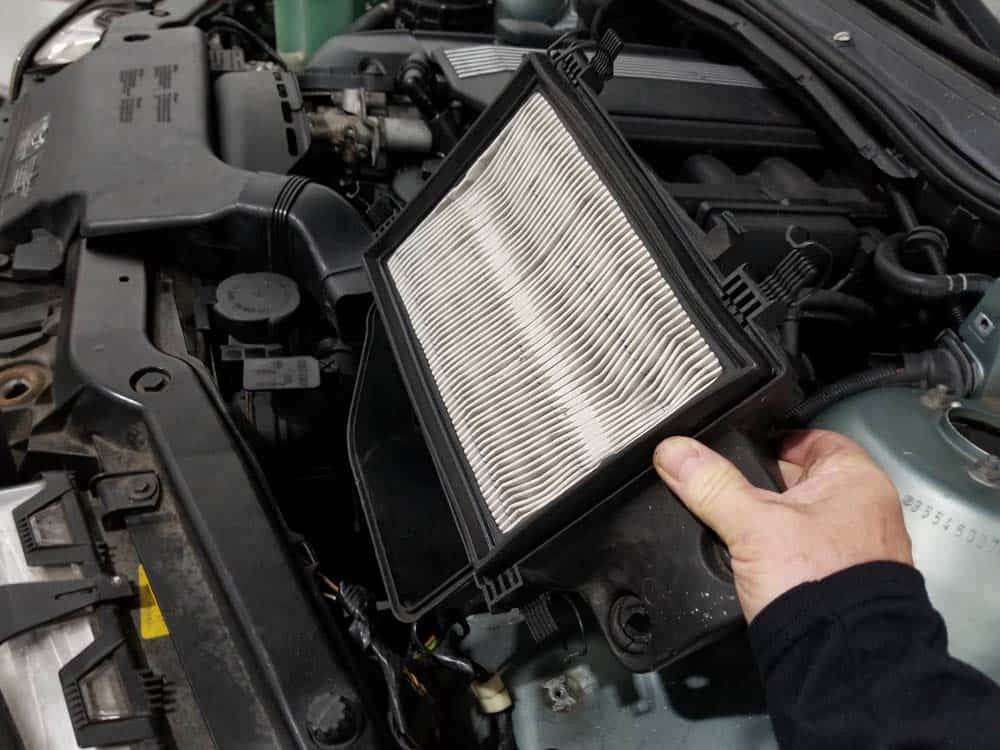
- Remove the plastic air intake tube.
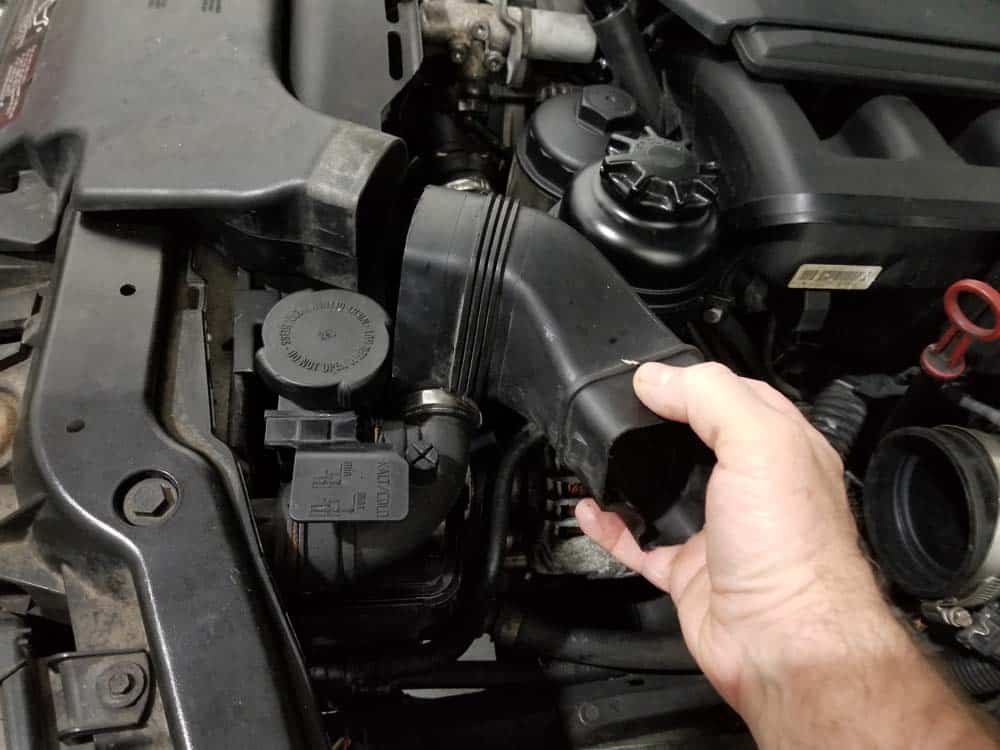
- Use a trim removal tool to remove the three plastics rivets anchoring the air intake tube to the frame of the vehicle. Remove the intake tube from the vehicle.
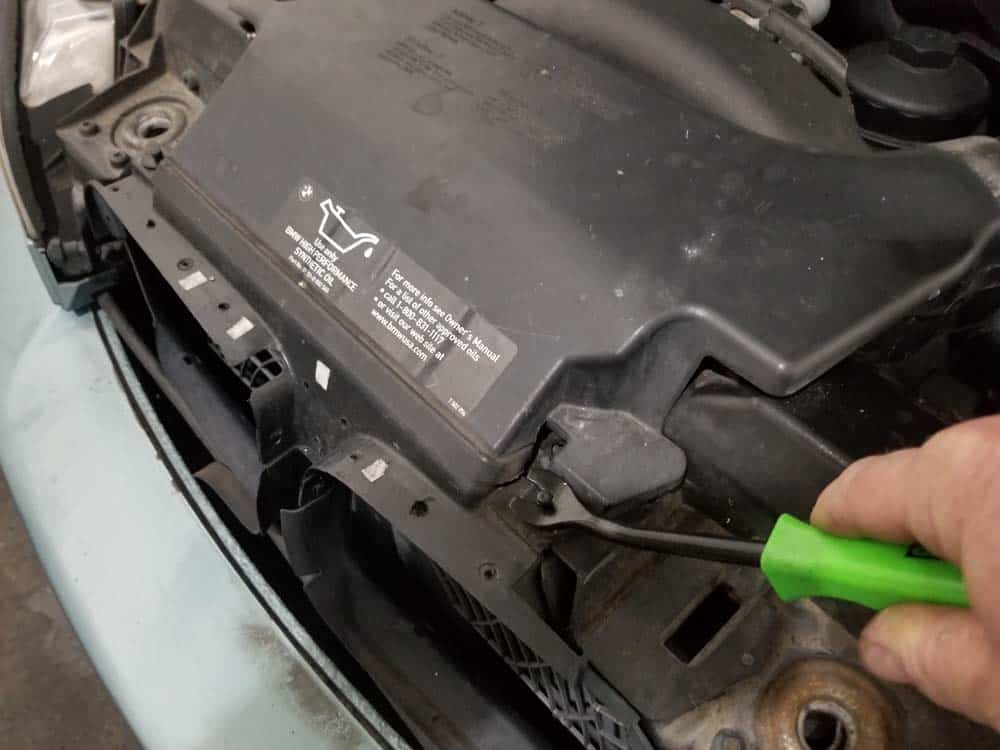
- Remove the air quality sensor and the wiring harness connector from the fan shroud and safely tuck out of the mode.
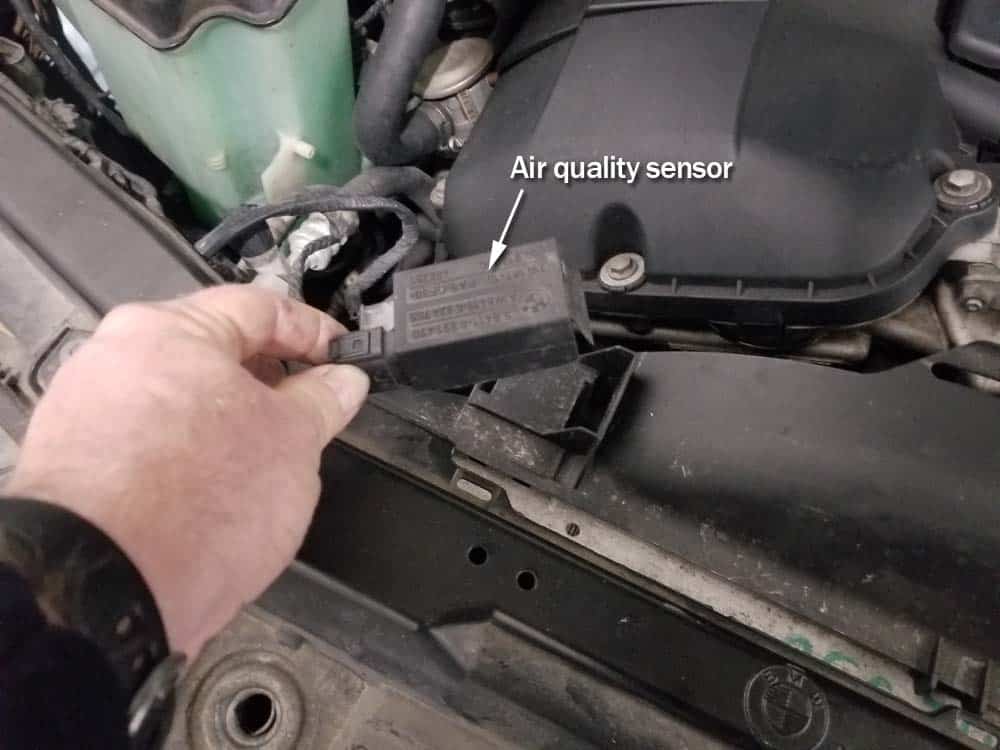
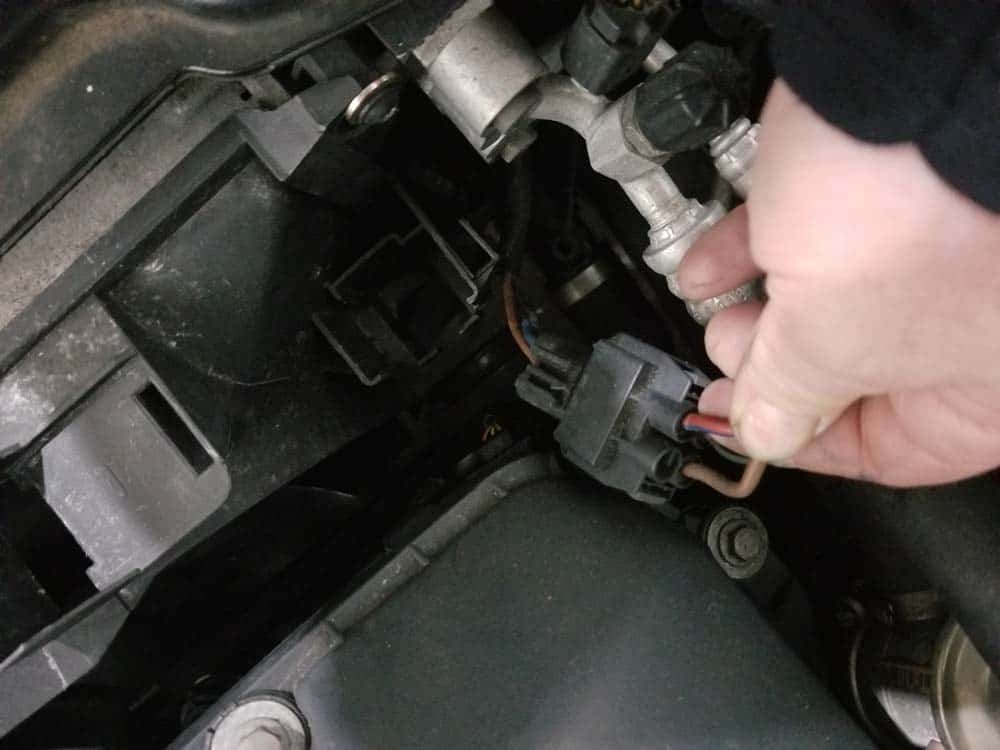
- Position a v gallon drain pan under the front of the vehicle.
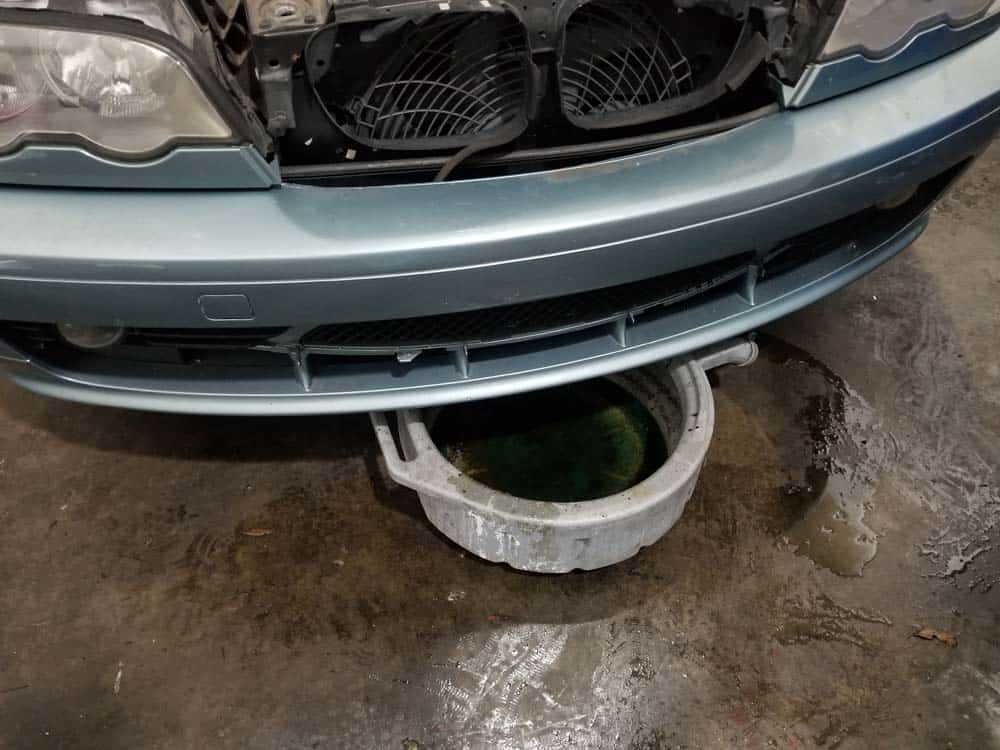
- Release the clips securing the upper radiator hose to the thermostat housing and the expansion tank. Remove the hose from the engine. The hose must be removed so you can proceeds clear access to the cooling fan clutch nut.
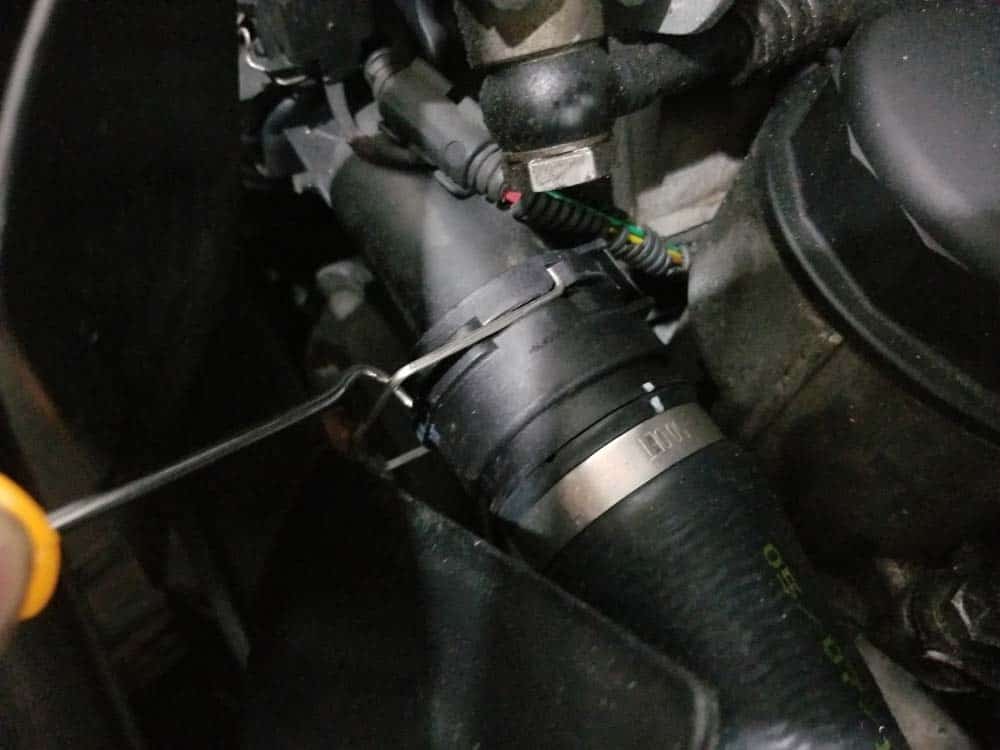
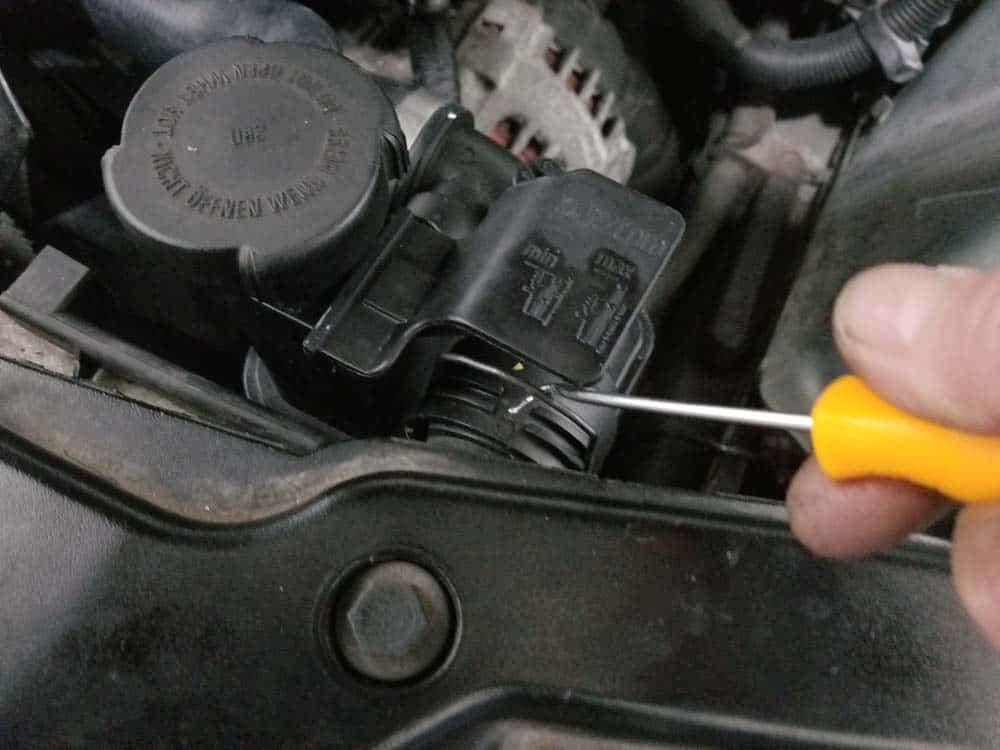
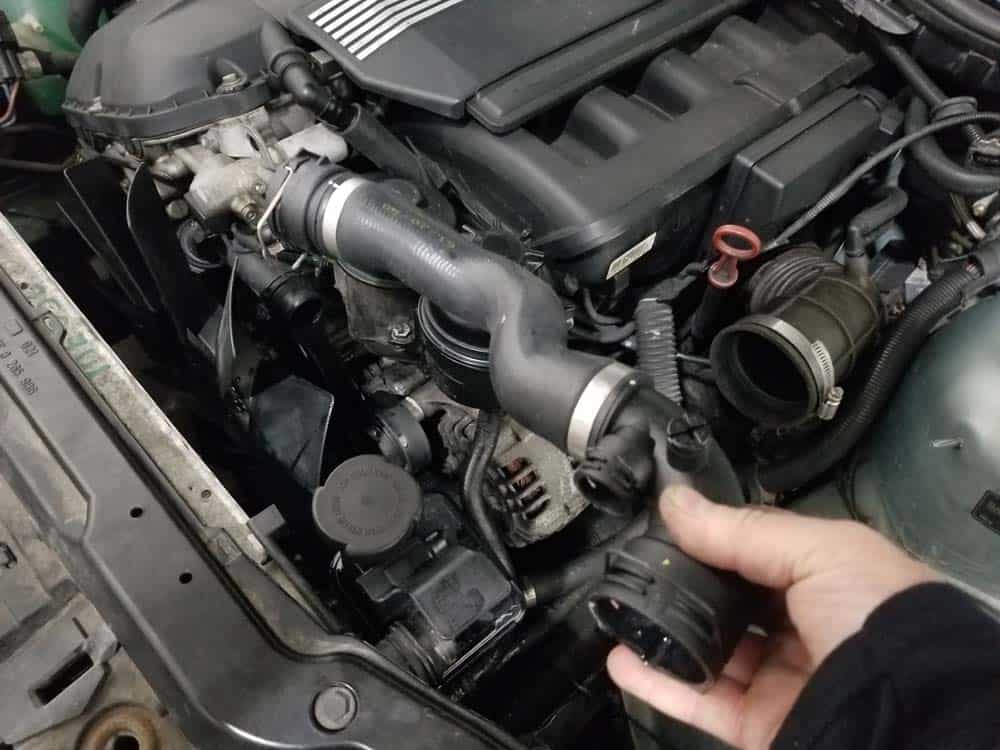
- Don't try and remove the fan shroud yet...it is easier to remove with the cooling fan and fan clutch. There is also less take chances of breaking the fan shroud if yous remove it with the cooling fan.
- Next, the infamous cooling fan and fan clutch must be removed from the water pump pulley. If the nut on the fan clutch is seized and cannot exist removed from the h2o pump caster with the special fan clutch removal tool (which is a very common occurrence), then yous will have to unbolt and remove the cooling fan from the clutch. Remember the fan clutch nut is a opposite thread...you must turn information technology clockwise to loosen information technology.
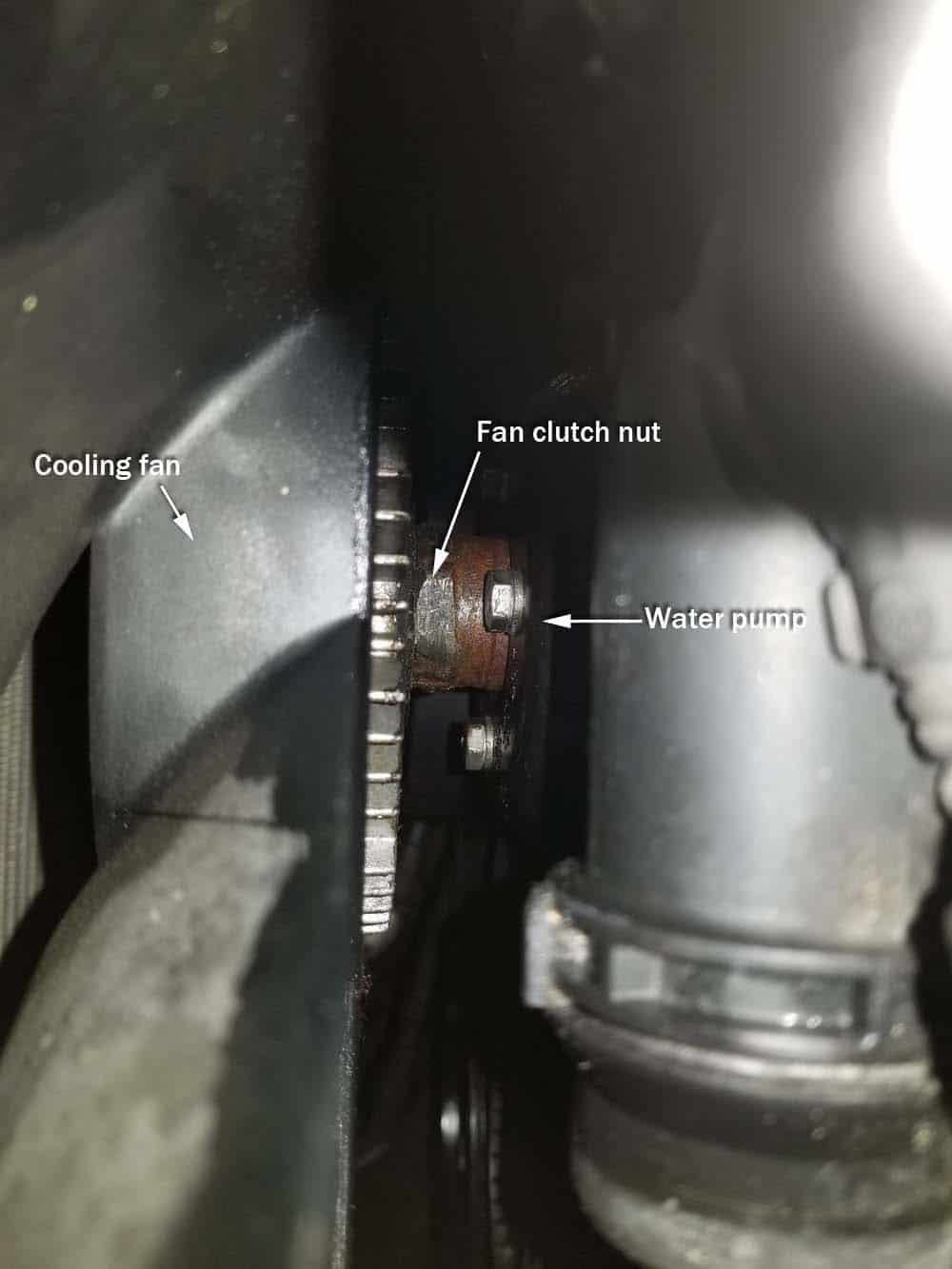
- The offset stride in all of this is to try and remove the fan clutch from the caster with the special fan clutch removal tool. Identify the fan clutch tool on the pulley and the clutch nut as shown in the post-obit image. Remember the fan clutch nut is a contrary thread...you must turn it clockwise to loosen it.
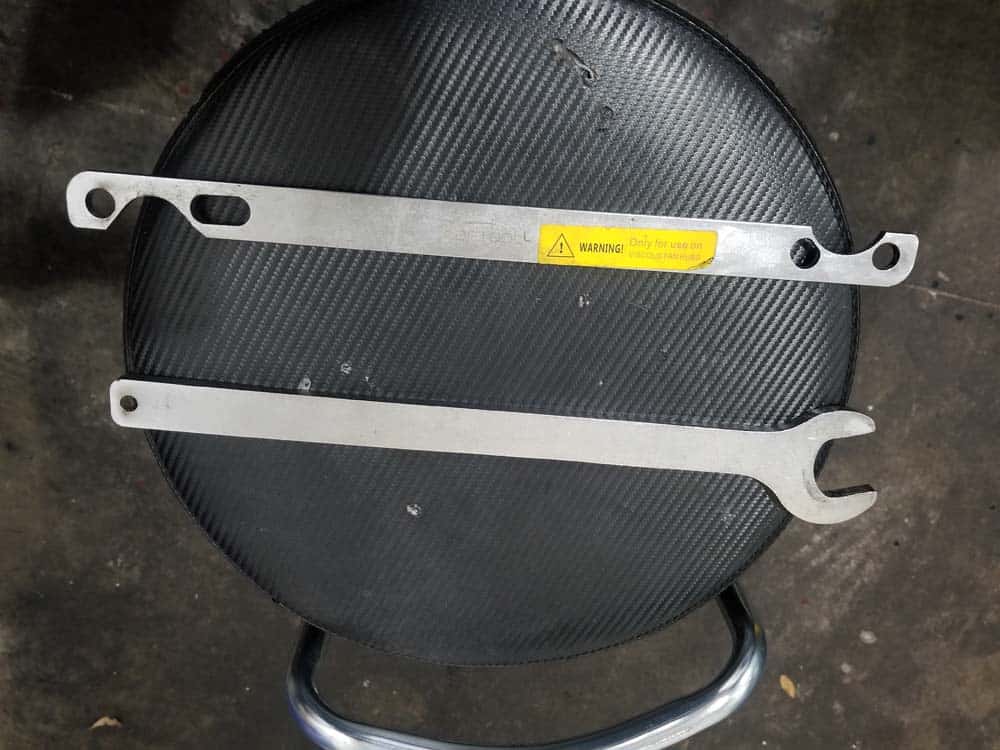
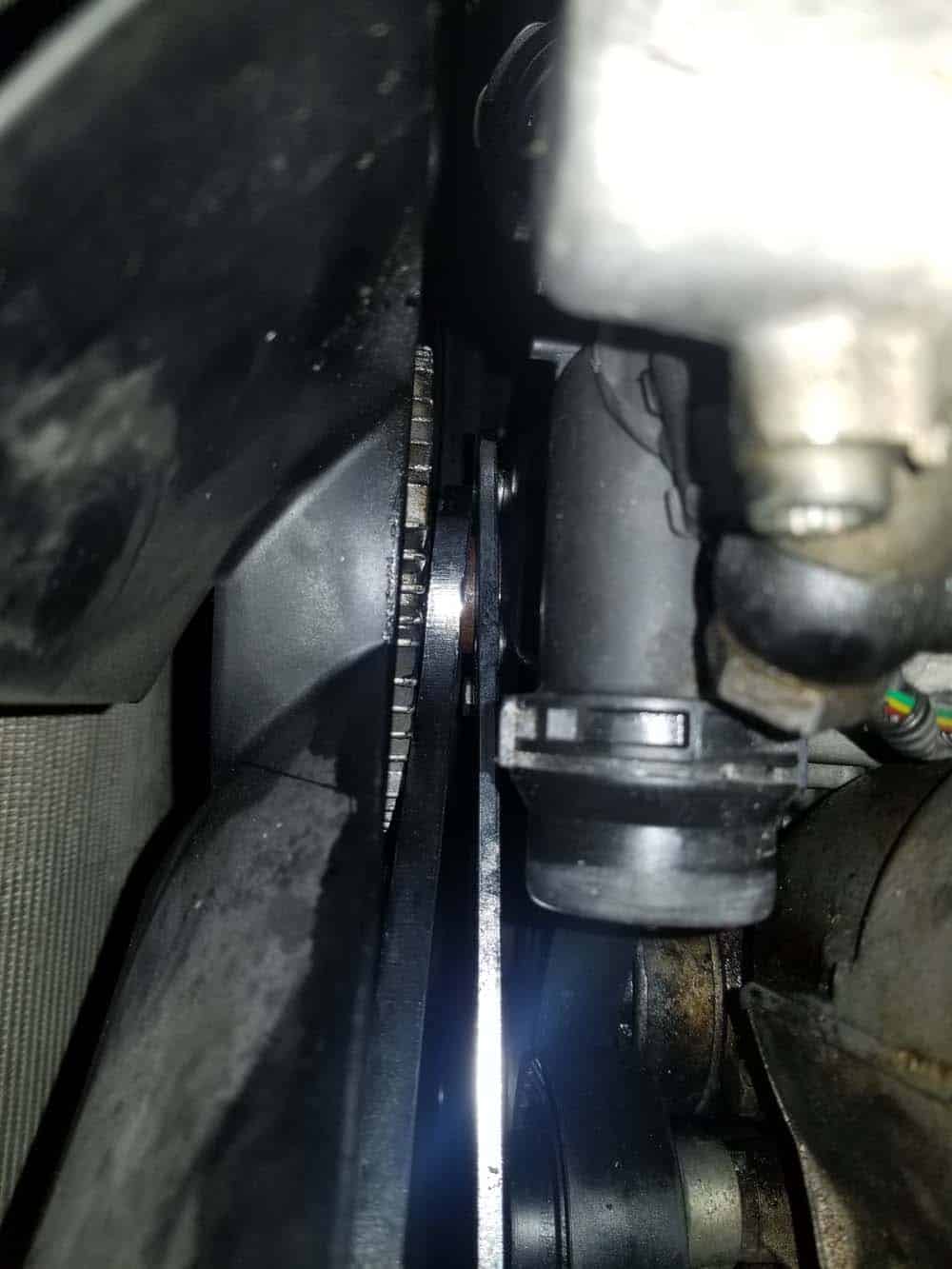
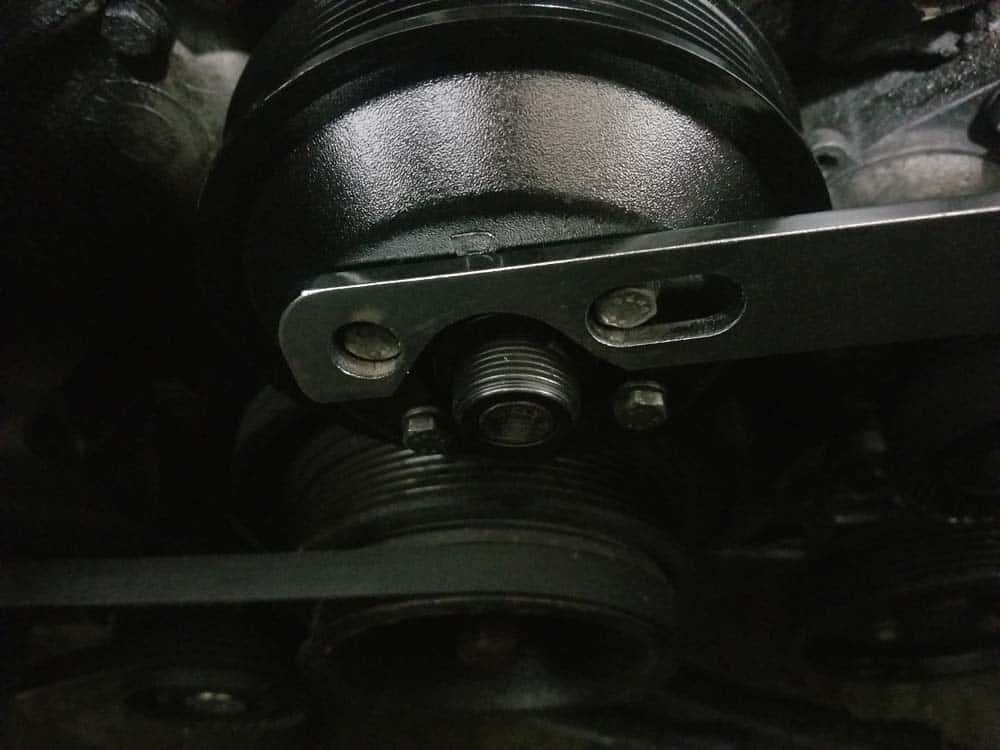
- The nut is a reverse thread...this ways yous must turn the nut CLOCKWISE to remove it (you would be surprised how many mechanics will still try and plough it the other direction...even after all of our obnoxious reminders).
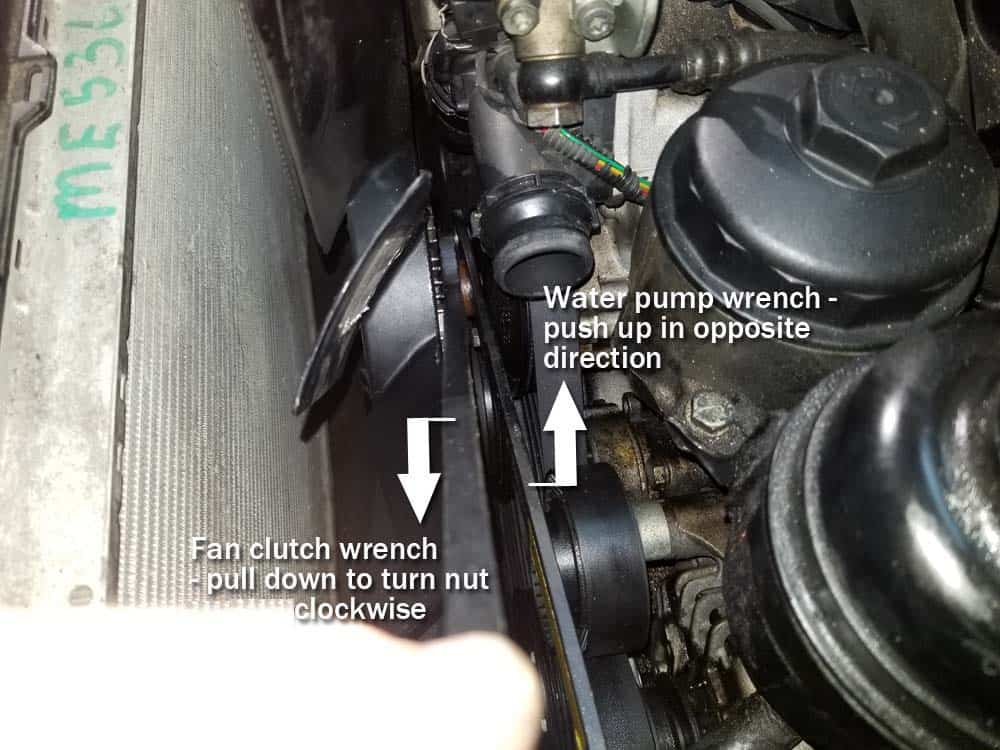
- If you can loosen the nut, and so spin the fan clutch nut off of the pulley. If the nut is seized and cannot be removed, then you volition demand to follow additional steps below to remove the cooling fan blades. Either way, go along to the adjacent step #17.
- Remove the right T27 torx radiator anchor spiral. This spiral also anchors the fan shroud to the radiator. The right side of the fan shroud is anchored to the radiator with a plastic rivet. Remove the rivet with a trim removal tool.
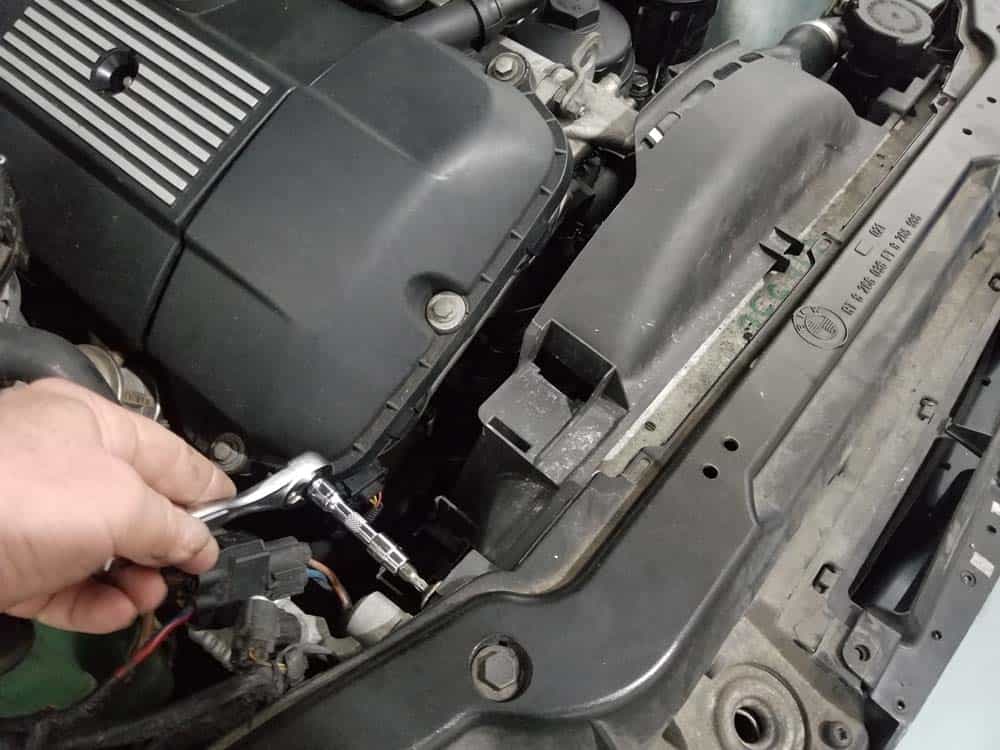
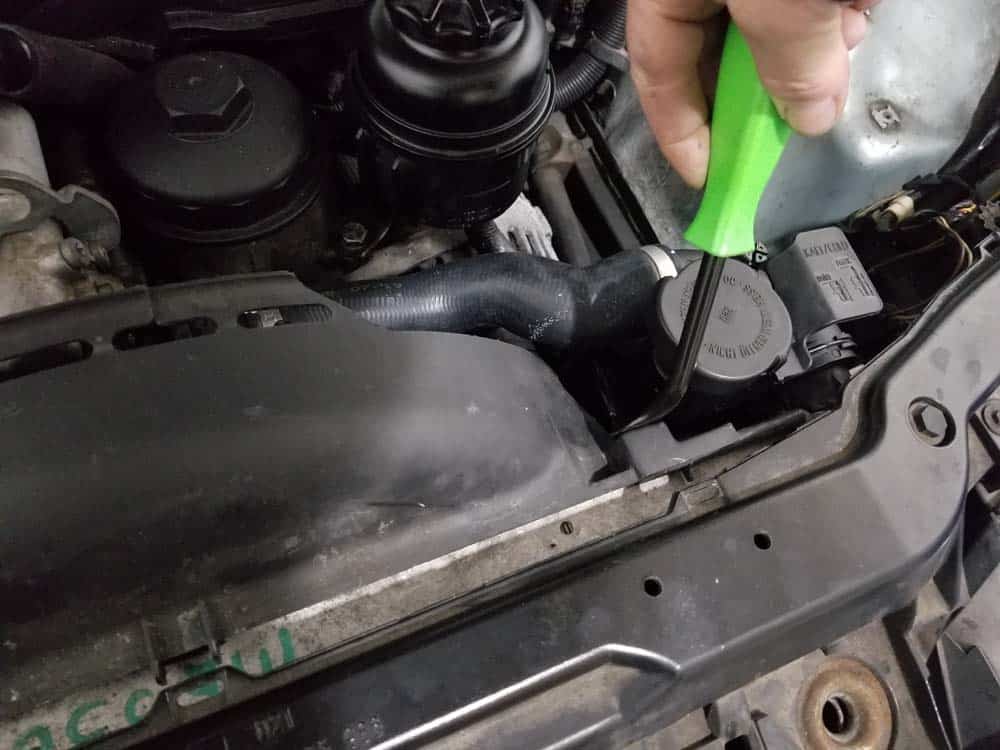
- If you were able to remove the fan clutch from the h2o pump pulley, grasp the shroud and the cooling fan and slowly remove them from the engine compartment togetherand continue to step 21. If the nut was seized and you could not remove the fan, proceed to the next step #19.
- If the clutch nut is frozen and y'all could not loosen information technology, slowly pull the shroud upward and out of the front of the vehicle effectually the cooling fan. Don't pull on it if it gets hung upward...yous may have to get under the front of the auto to assist guide it behind the fan blades. Take your fourth dimension and do your best to get information technology out with minimal damage to the shroud.

- Utilize a T30 torx bit to remove the three fan clutch mounting bolts. Remove the cooling fan from the vehicle.
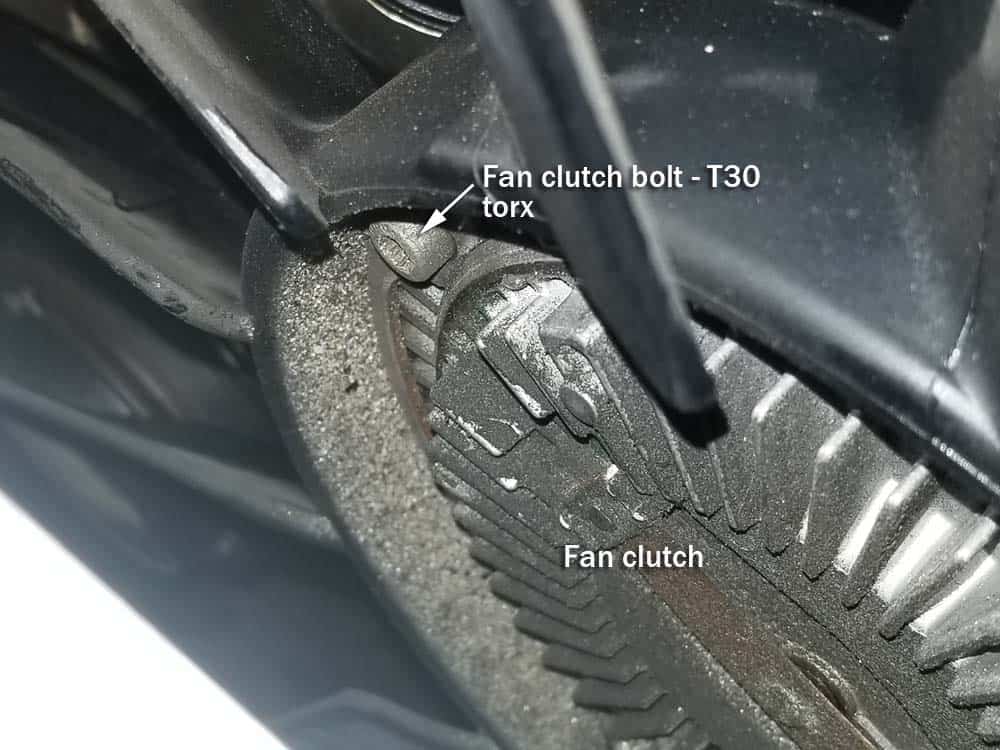
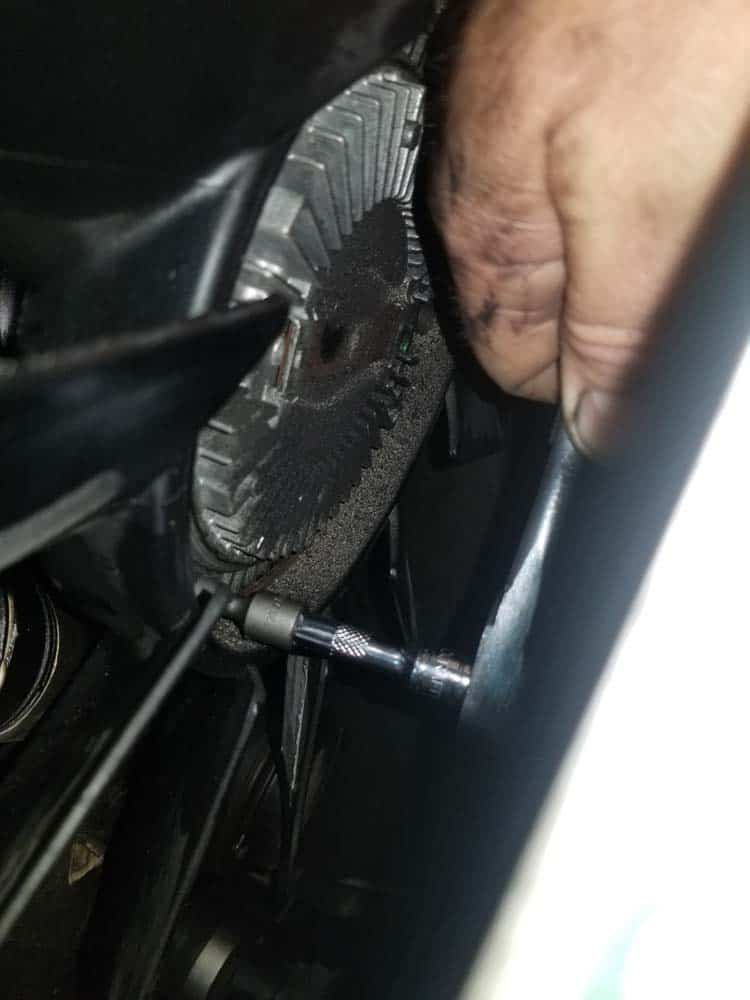
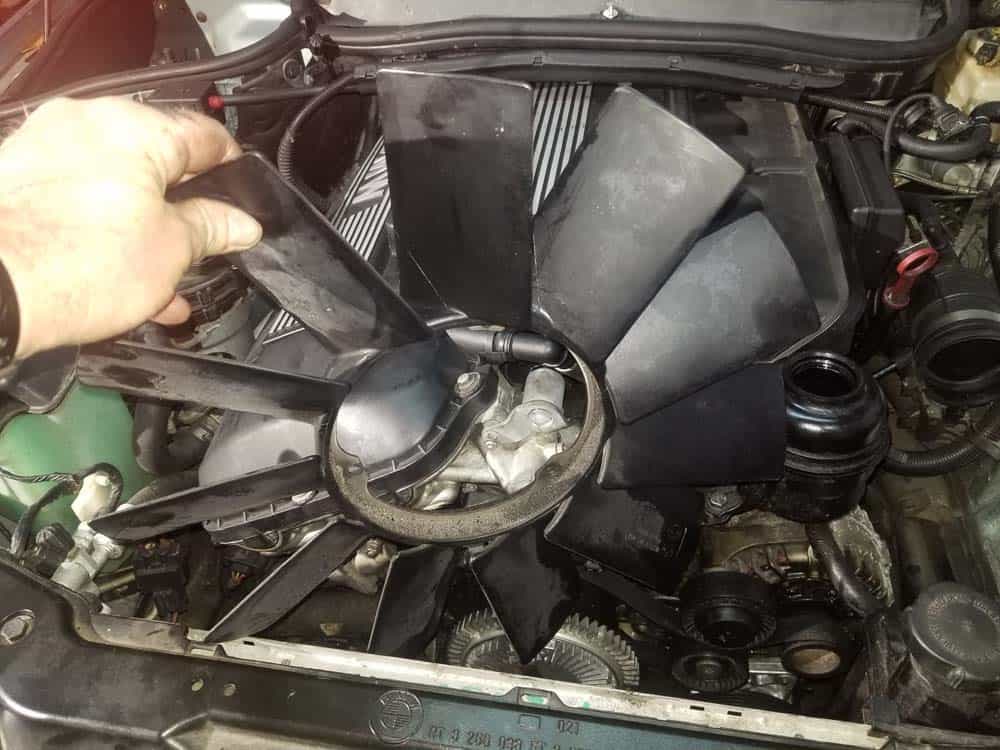
- Y'all now accept clear access to the thermostat housing. First by removing the lower radiator hose that runs from the correct side of the thermostat to the bottom of the radiator. Release the metal clip and pull it costless...brand sure you lot accept a drain pan under it to catch any coolant.
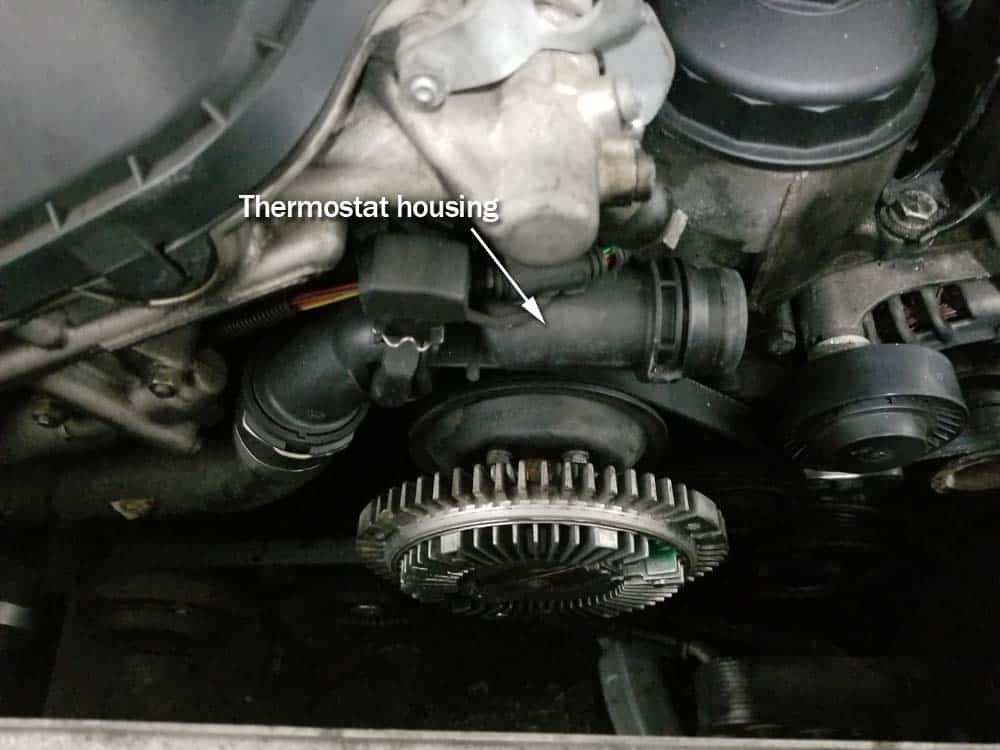
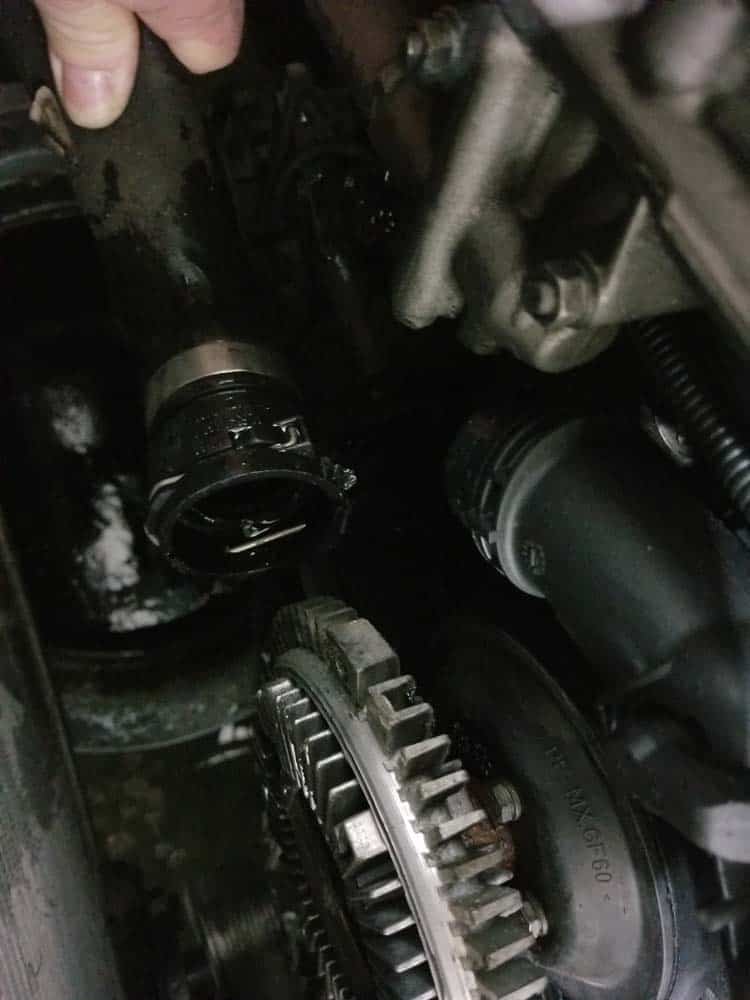
- Side by side, remove the thermostat temperature sensor connectedness.
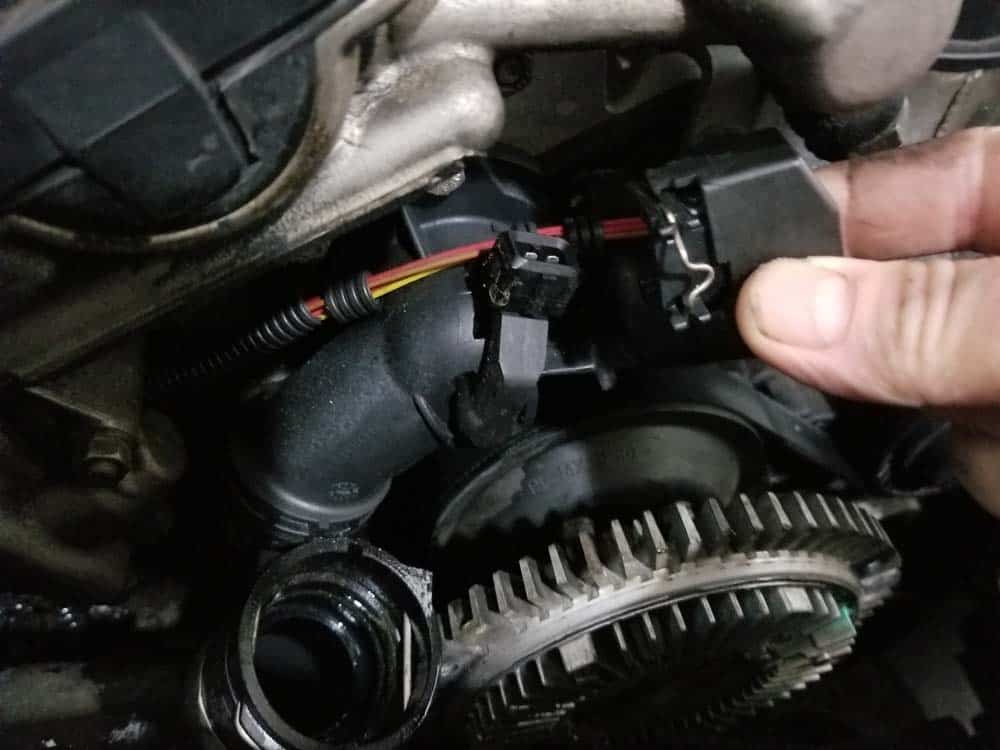
- The thermostat housing is anchored to the front end of the engine with iv bolts. Iii of the bolts are 10mm and i is 13mm. If you were not able to remove the fan clutch in stride thirteen above, the bottom two can be a scrap of a challenge to get out. Utilize patience when removing them.
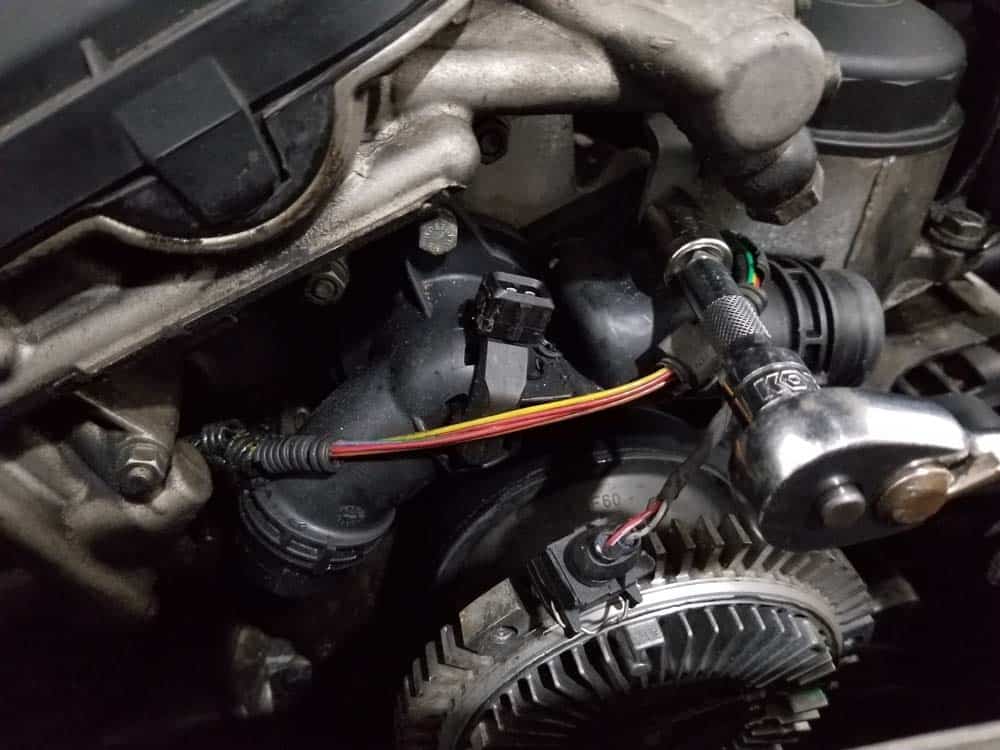
- Grasp the thermostat housing and pull it loose from the forepart of the engine. Remove the housing from the car.

Section 2 - Installing the New BMW E46 Thermostat
Installing the new thermostat is a very simple procedure. It is very important that the surface of the engine is thoroughly cleaned where the new thermostat mounts; whatever oil, grease, or debris can affect the thermostat gasket's ability to seal and create a leak. It is also very important to add multipurpose grease to the fan clutch nut to prevent it from seizing in the future.
- Use CRC Brakleen to thoroughly clean the engine where the thermostat housing mounts. Make certain to get all of the dirt, oil and grime off. Not cleaning it thoroughly could prevent the new gasket from sealing correctly and may create future leaks.
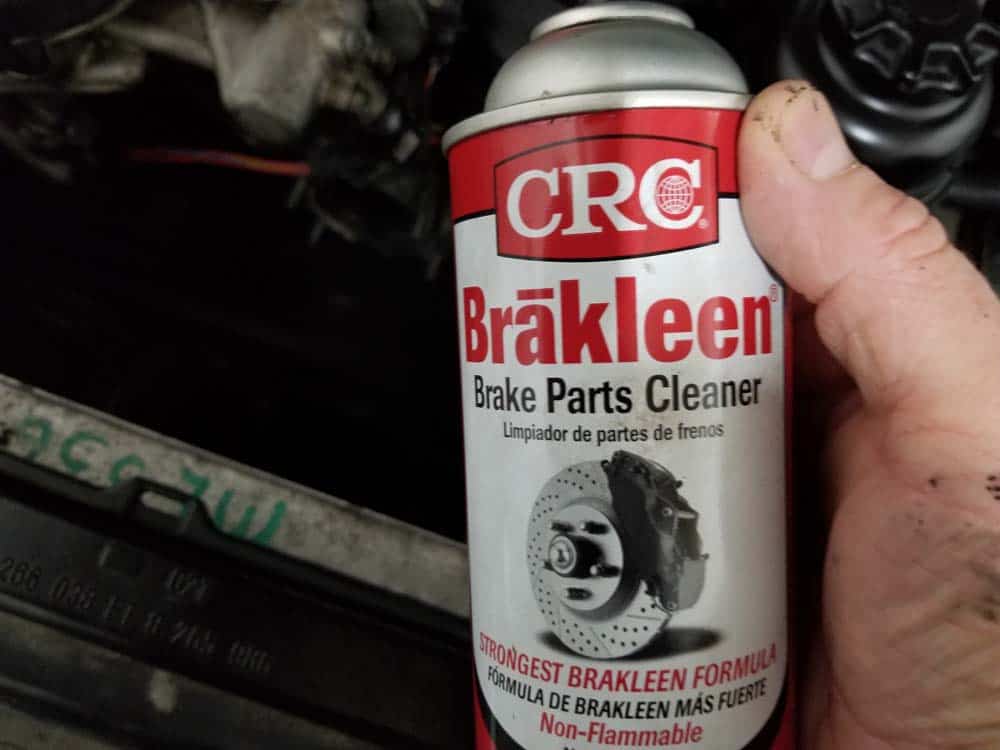
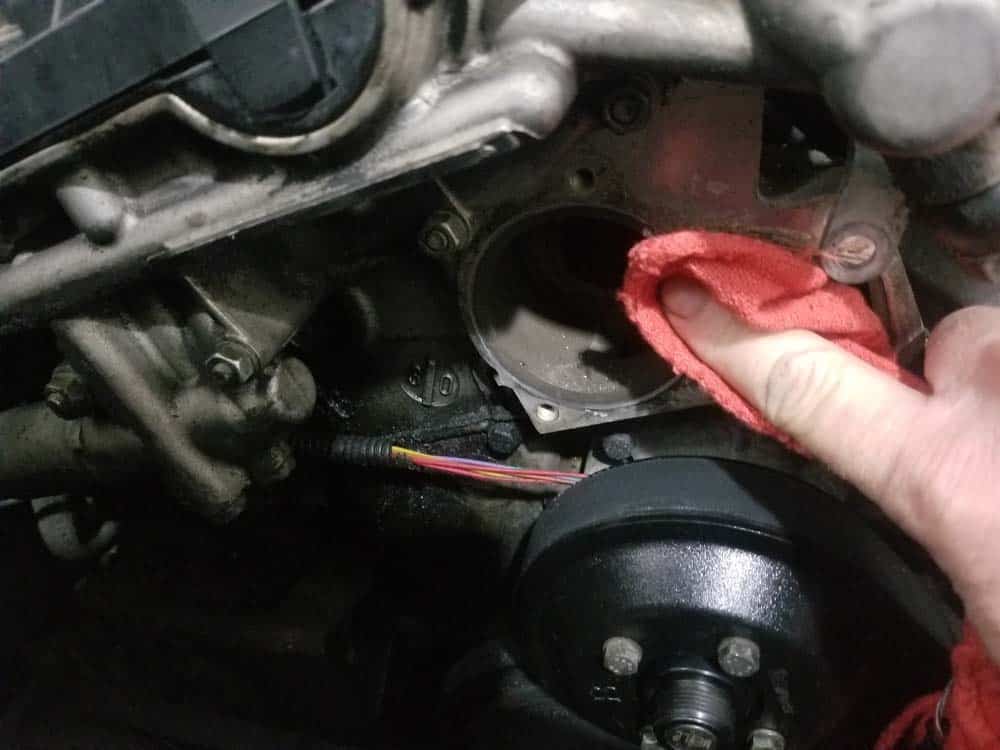
- Unpack the new thermostat. Verify you have the correct part number.
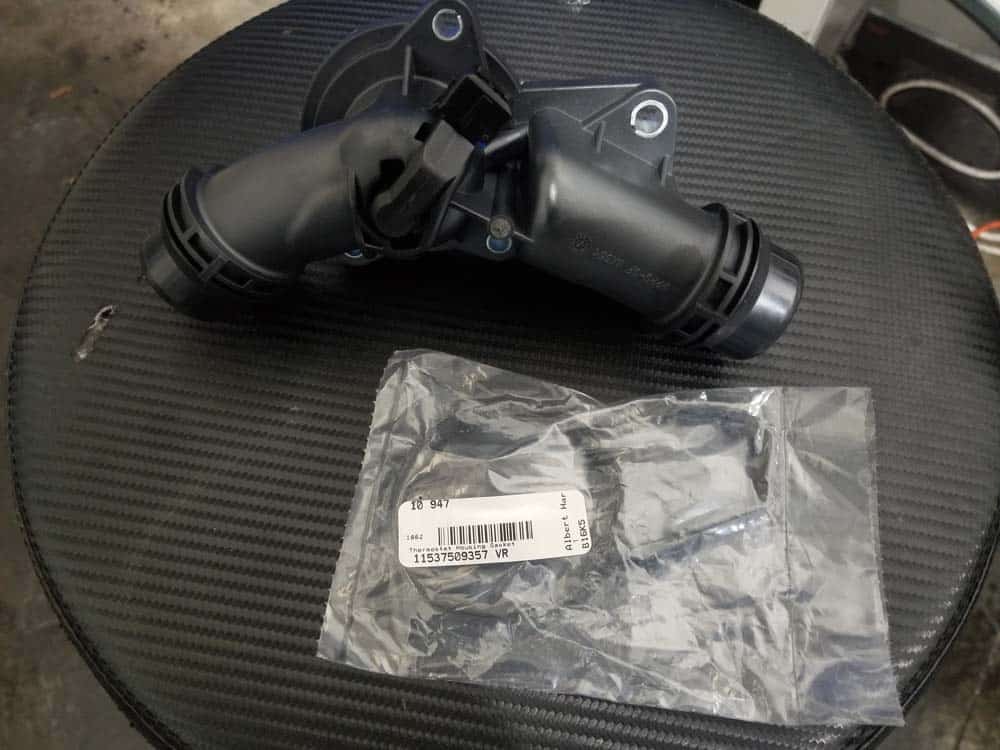
- Verify your new thermostat comes with a gasket; commonly they are already pre-installed in the housing. If the gasket is non pre-installed or you purchased the thermostat and gasket separately, install the new thermostat gasket in the thermostat housing. Make sure it is seated correctly so it doesn't get pinched during installation.
- Install the new thermostat housing on the front end of the engine and finger tighten the four mounting bolts. Torque the mounting bolts to 10Nm (seven.5 ft-lb).
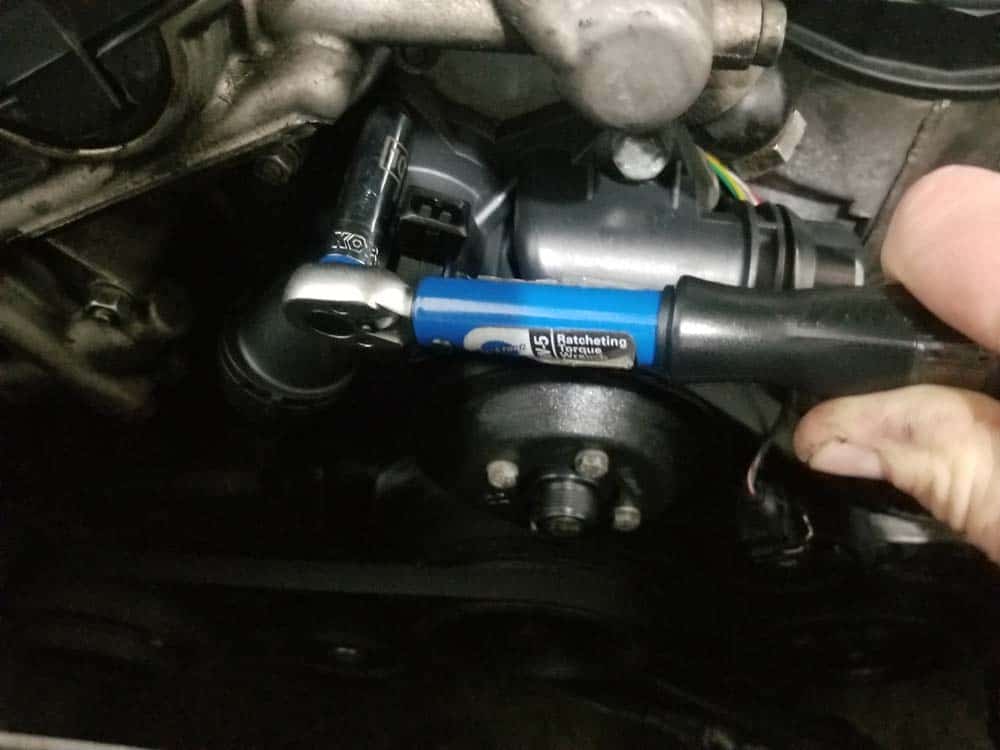
- Close the locking prune on the lower radiator hose so mount onto the thermostat housing. Push button on the hose until you hear information technology click into its locked position.
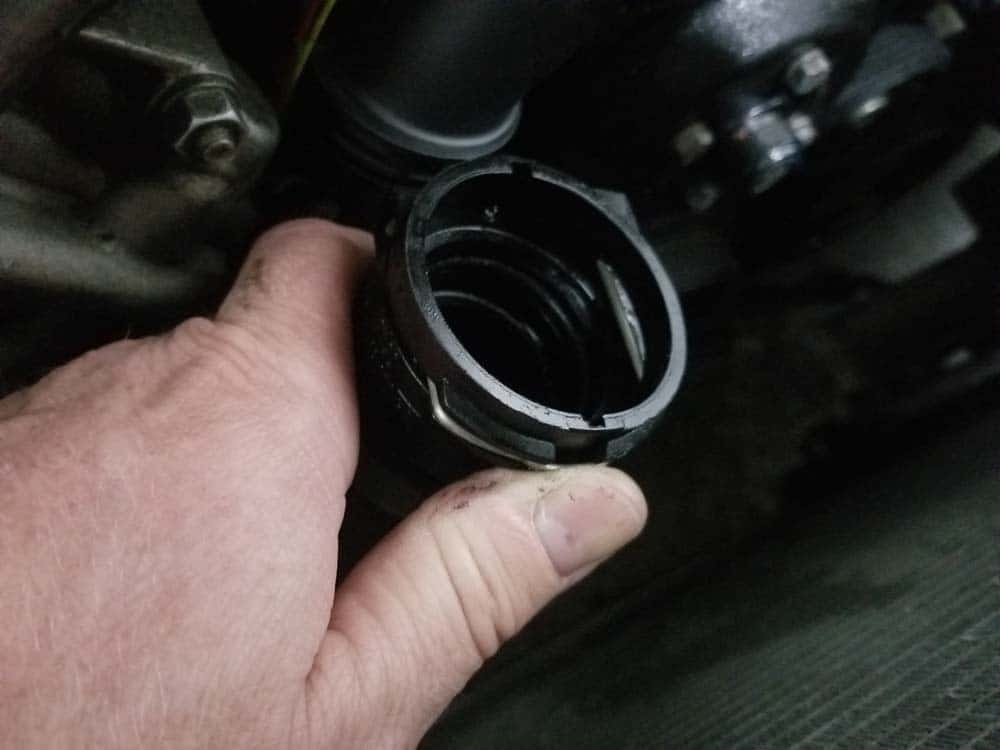
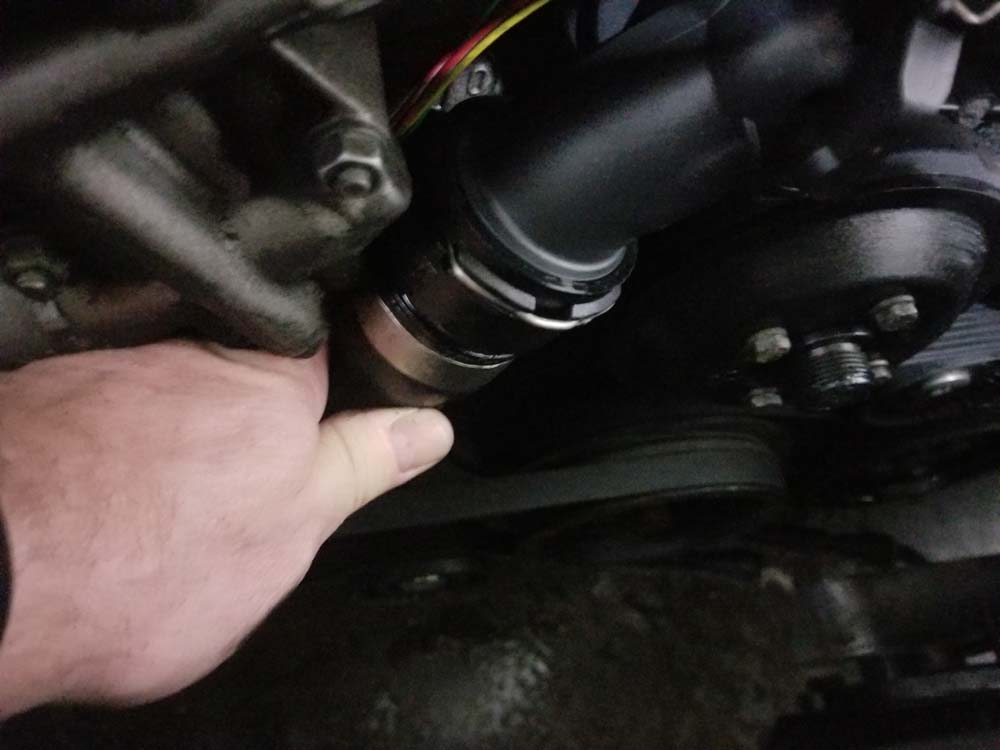
- If you had to remove your cooling fan from the clutch because of a seized nut, reinstall it using the three torx mounting bolts. Make sure y'all have the fan blades facing the correct direction. Torque the mounting bolts to 10 Nm (7.v ft-lb).
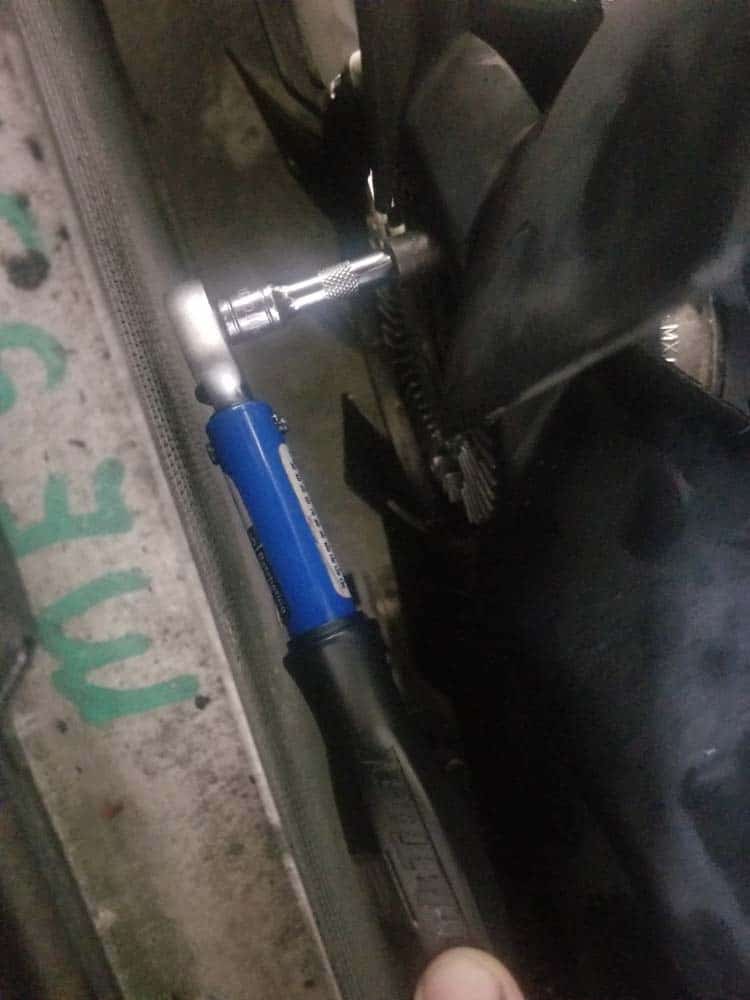
- If you were able to remove your cooling fan using the fan clutch tool, liberally utilise some multipurpose automotive grease to the clutch nut threads. This will prevent it from seizing up in the future and arrive easy to remove for futurity repairs.
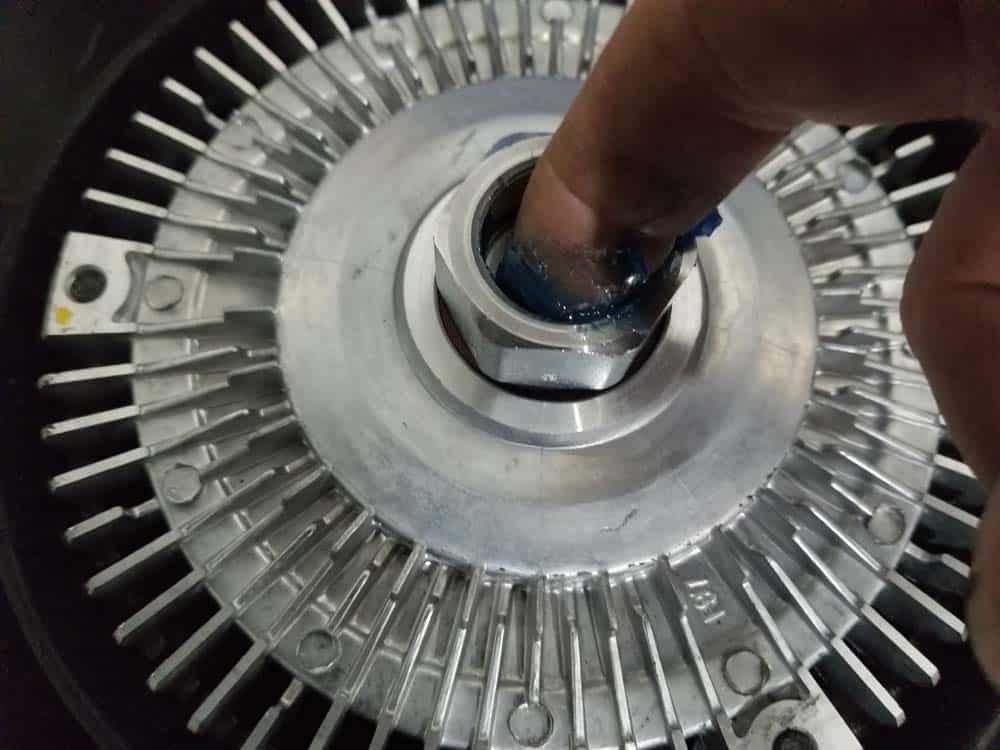
- Lower the fan shroud and the cooling fan together into the front of the vehicle. Spin the cooling fan onto the h2o pump counterclockwise to tighten. Utilize the special fan clutch tool to tighten the nut as snug as you can get it. Since information technology is a reverse thread, it is cocky tightening and then you practise not take to worry about torquing it.
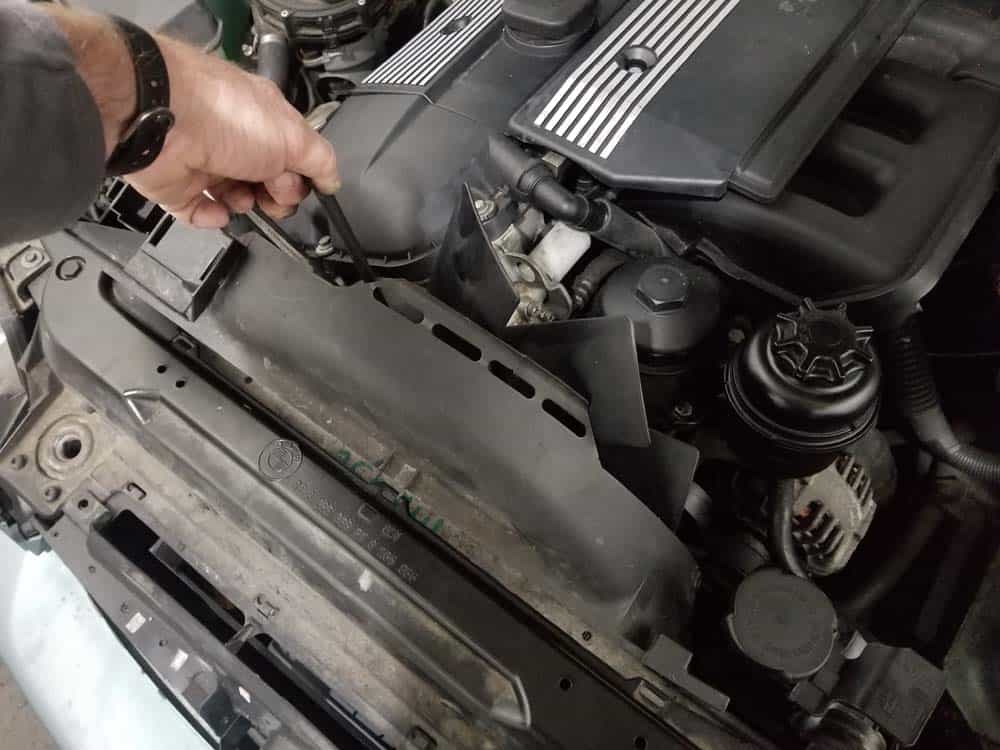
- Reinstall the fan shroud mounting fasteners, the air quality sensor and the wiring harness connection.
- Install the upper radiator hose dorsum onto the thermostat and the coolant expansion tank.
- Reinstall the intake tube, intake muffler and the MAF sensor.
- Reinstall the belly pan under the engine.
Department three - Refilling the Organization with Coolant, Bleeding and Testing
Refilling and bleeding the coolant system in your BMW E46 3 series car is a very simple procedure. The goal is to remove any air bubbles trapped in the coolant line that could potentially cause the engine to overheat. Unlike many other repair articles, the BMW Repair Guide uses the "double bleed" approach on their BMW E46 3 series cars. This is a proven method that we take used for years with 100% success. The double bleed method entails purging the air out of the coolant organisation twice; once with the engine off, and and then over again with the engine running. We have found this to be the most complete method of removing all of the air out of the E46 cooling system.
- Only use Genuine BMW Antifreeze/Coolant mixed 50/l with distilled water in your vehicle. Using whatever other brand of antifreeze/coolant in your BMW is strongly discouraged.Genuine BMW Antifreeze/Coolant was specifically engineered for your BMW...other brands may not absurd your engine correctly.
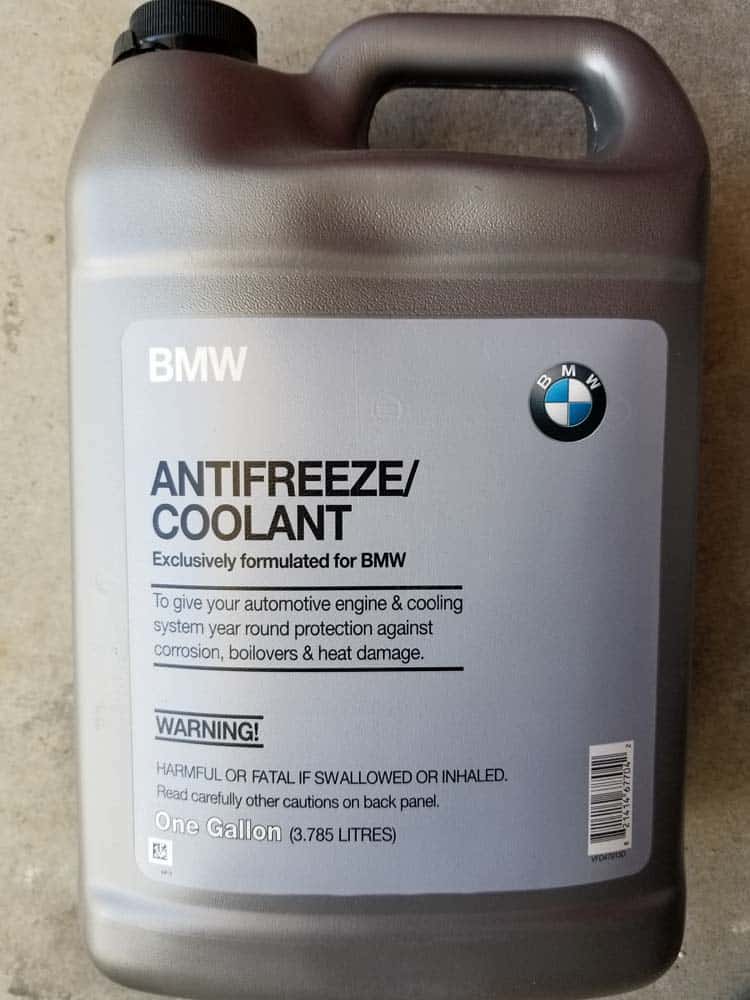
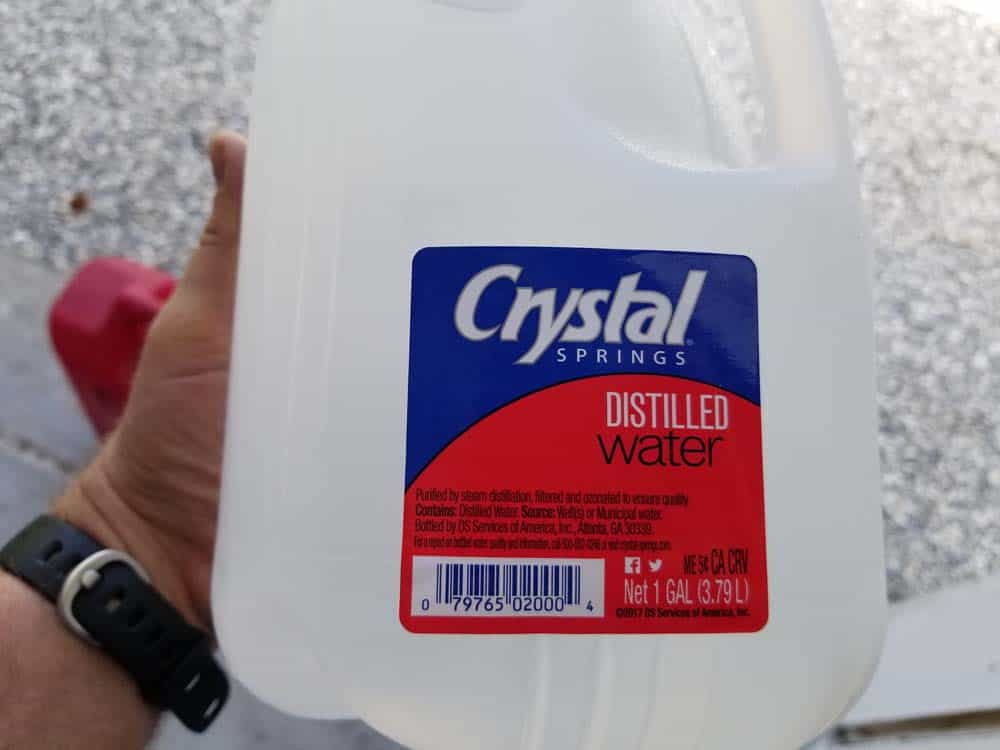
- Loosen the bleed spiral on the upper coolant hose.
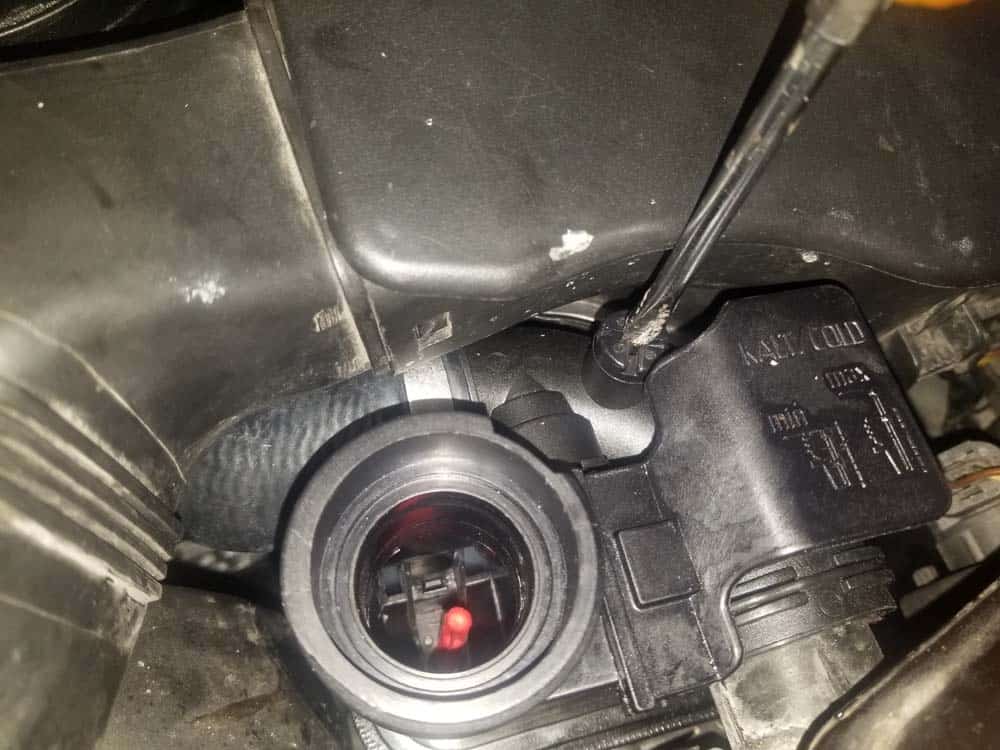
- Turn the ignition on. Do not showtime the vehicle.
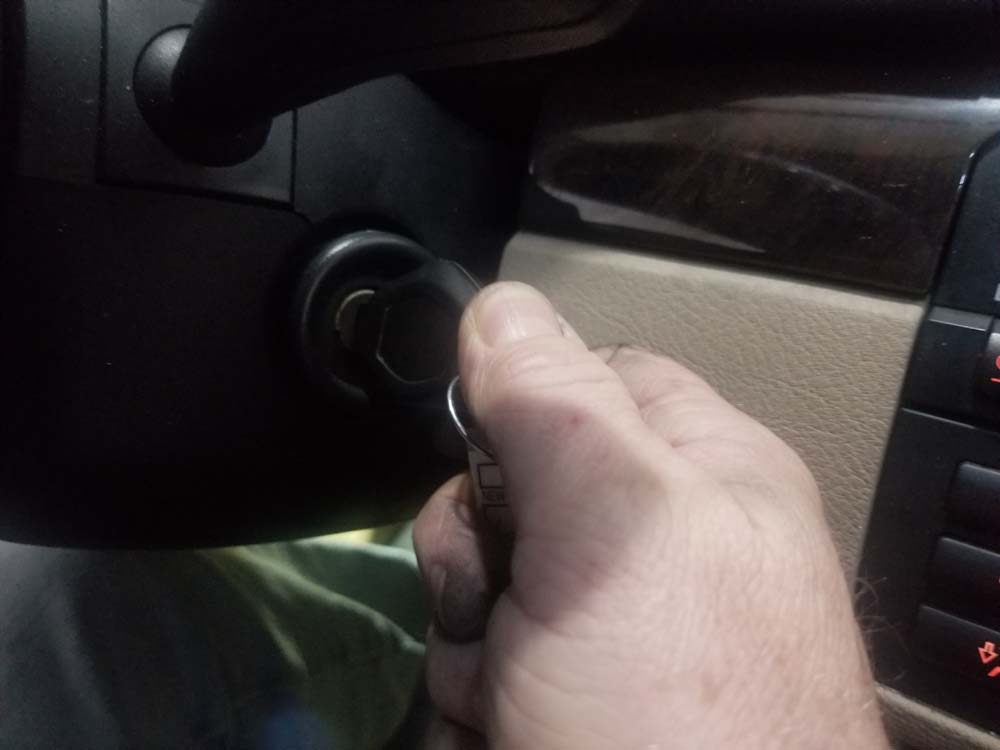
- Set the HVAC temperature controls to full warm and the fan speed to its everyman setting (this opens the heater core and activates the secondary electric coolant pump).
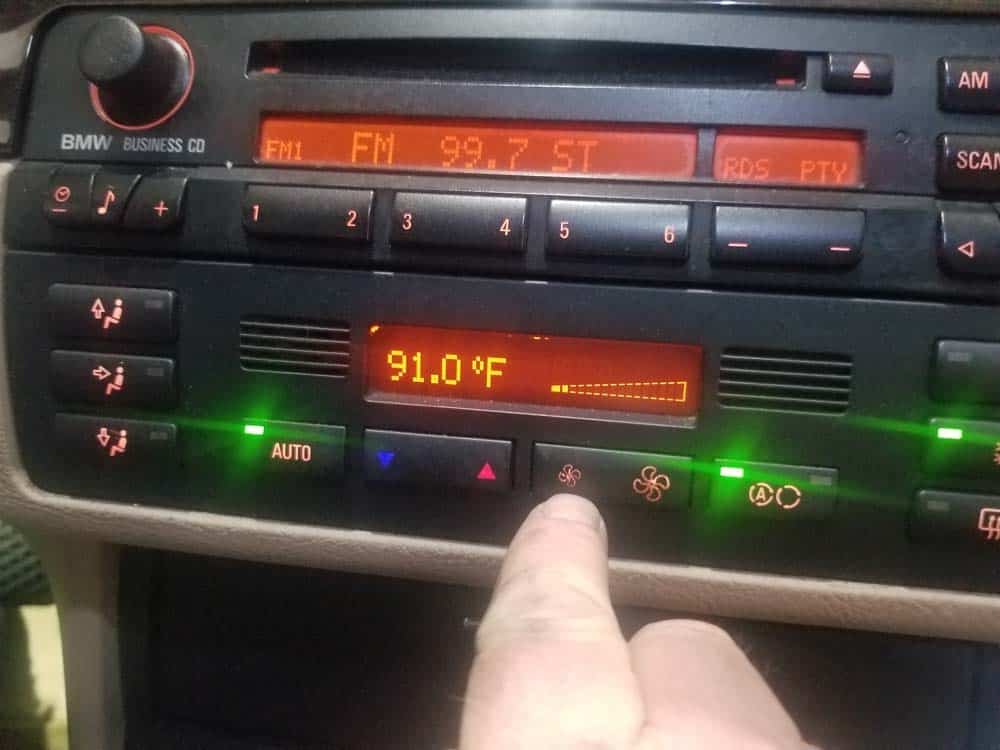
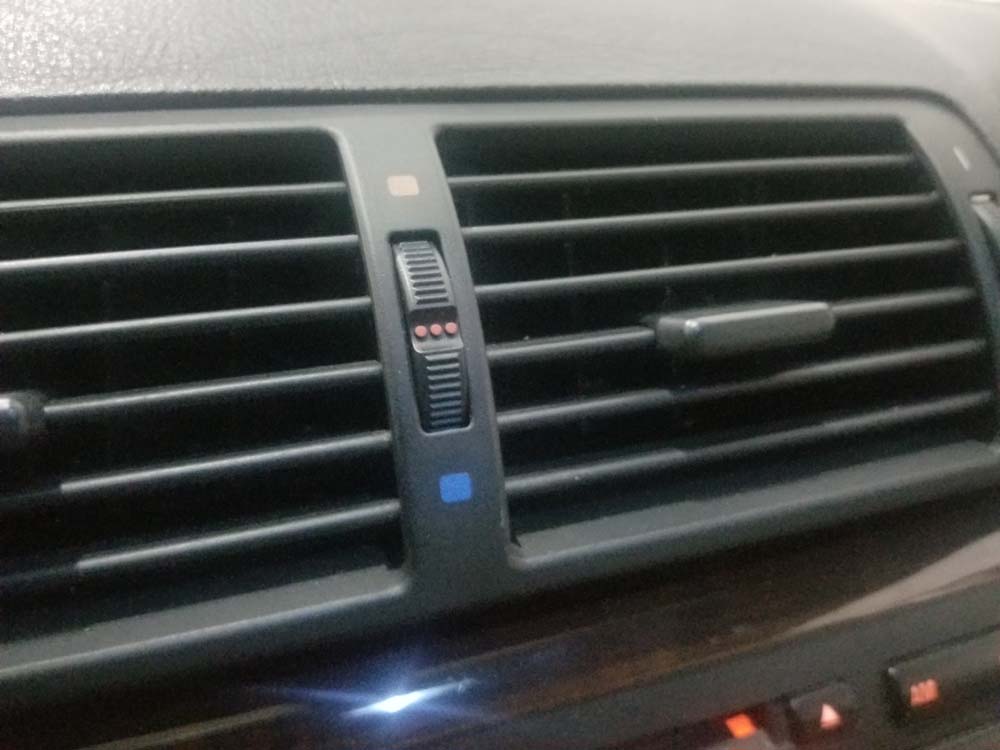
- Slowly fill the expansion tank with coolant until it starts to spill from the bleeder screw.
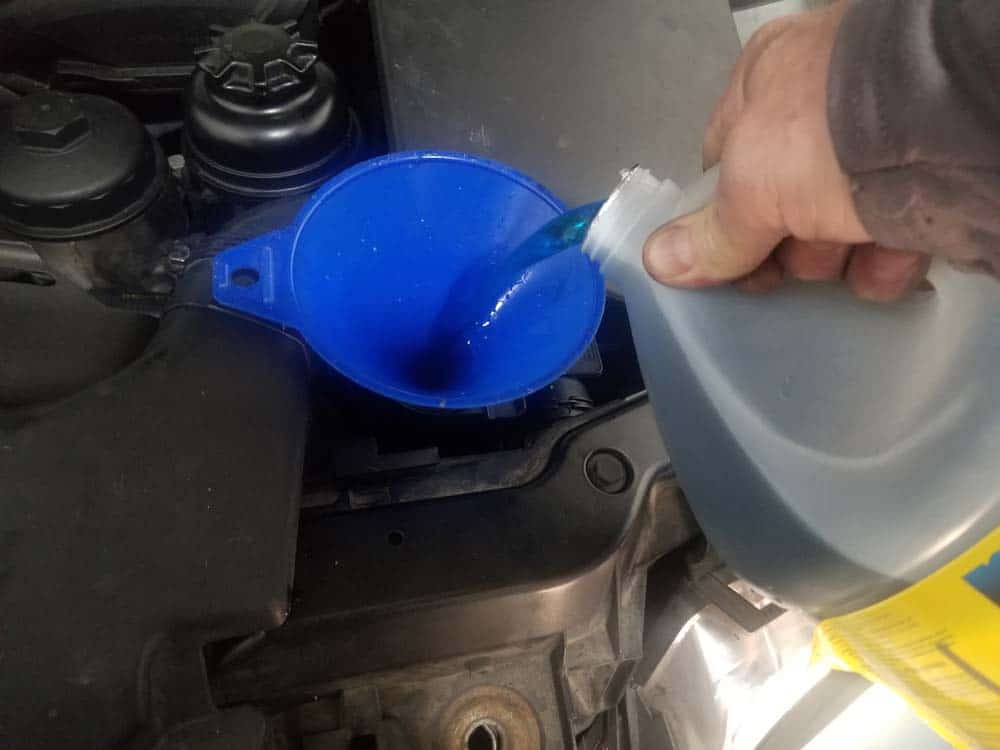
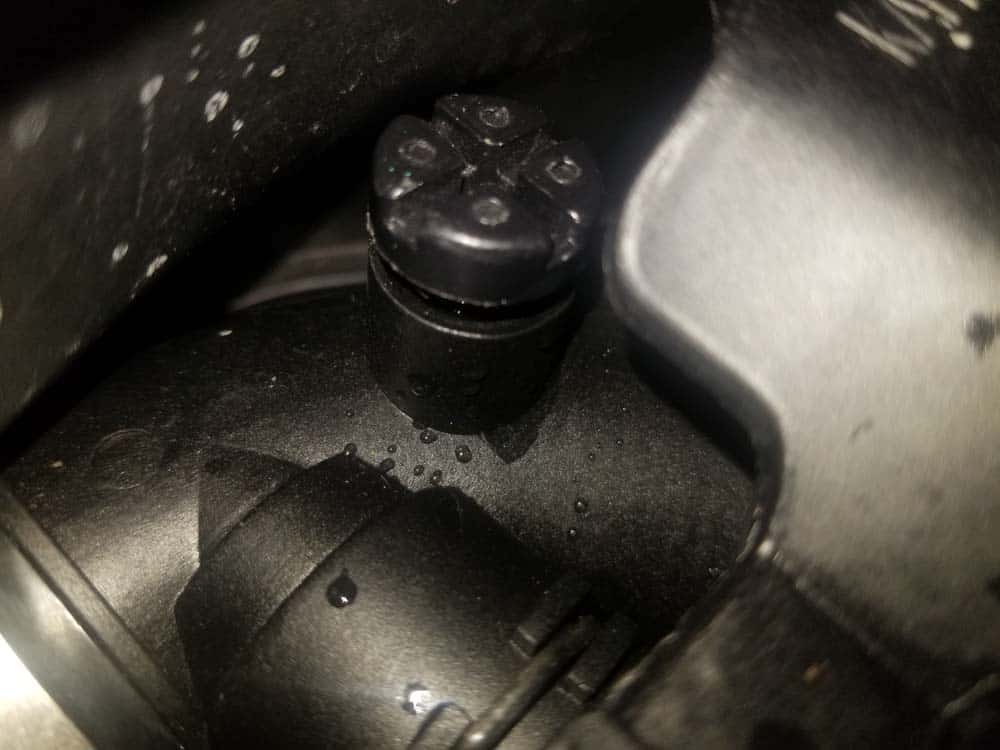
- When the coolant spilling from the drain screw is free of air bubbles (just a steady stream of coolant), tighten the screw and supervene upon the expansion tank cap.
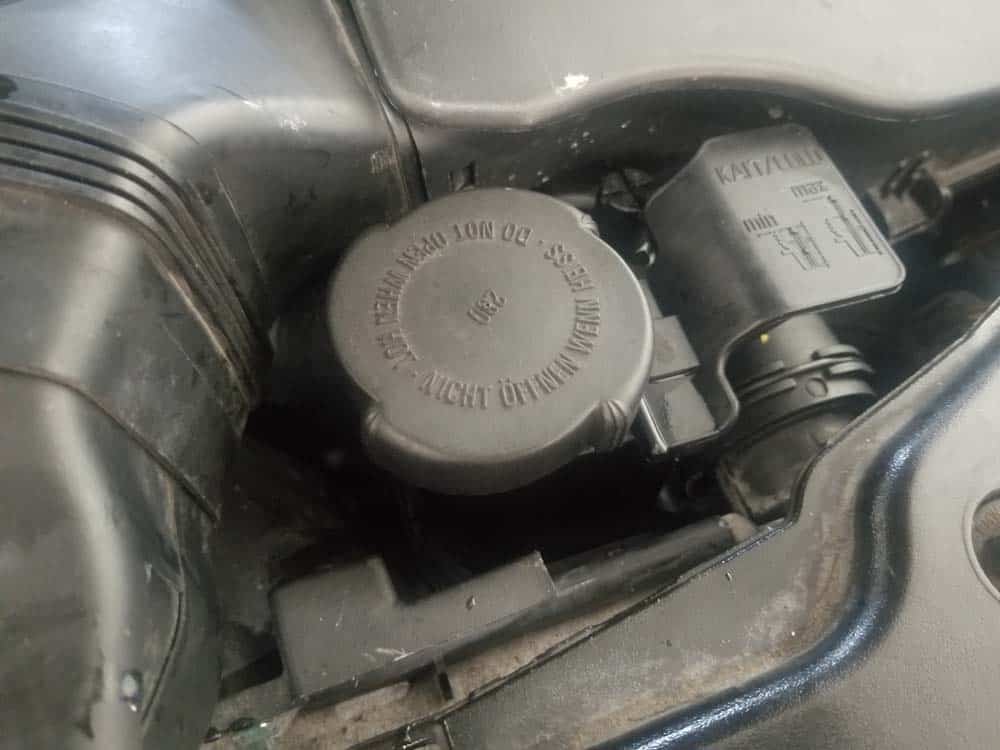
- Start the engine.
- With the engine running, loosen the bleeder spiral once more. You should get more air bubbling coming out until there is a steady stream of coolant being pushed out of the bleeder pigsty. Tighten the bleeder screw.
- Let engine to reach operating temperature (well-nigh 5 minutes if cold). Keep an eye on the engine temperature gauge...the needle should stay right in the middle. Check all of the hoses for leaks.
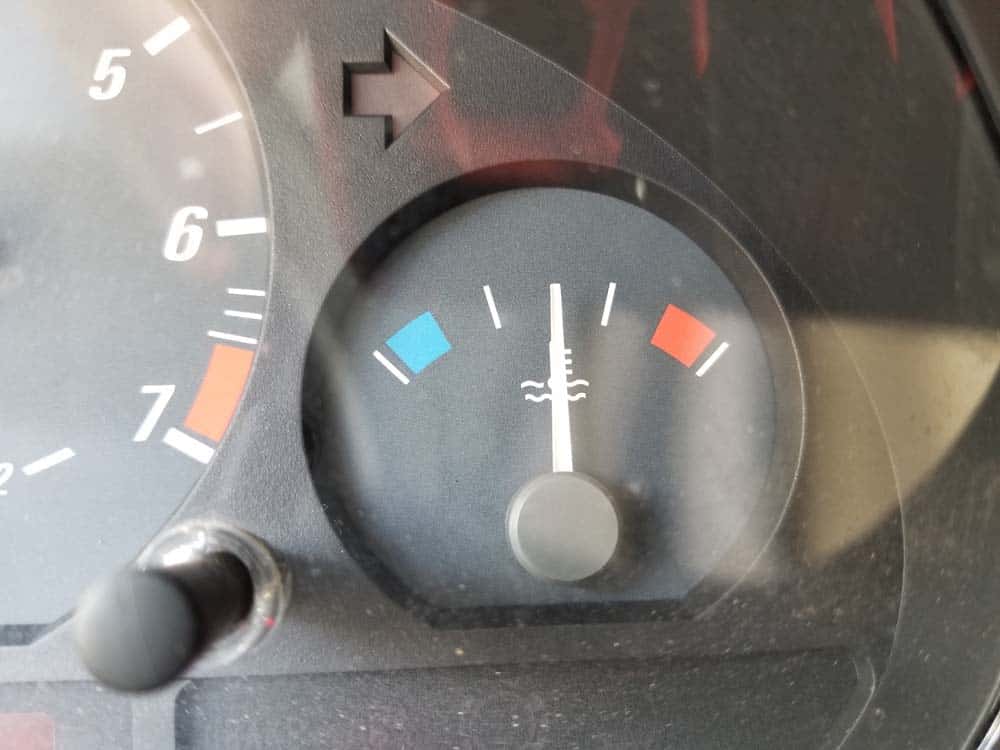
- Allow the engine to cool down. Recheck the coolant level in the expansion tank and top off if necessary.
BMW E46 Thermostat Replacement Finished
Source: https://bmwrepairguide.com/bmw-e46-thermostat-repair-1998-2006-3-series-all-models/
Posted by: pintodeshe1976.blogspot.com

0 Response to "How To Change A Thermostate On A 2000 Bmw 323i"
Post a Comment